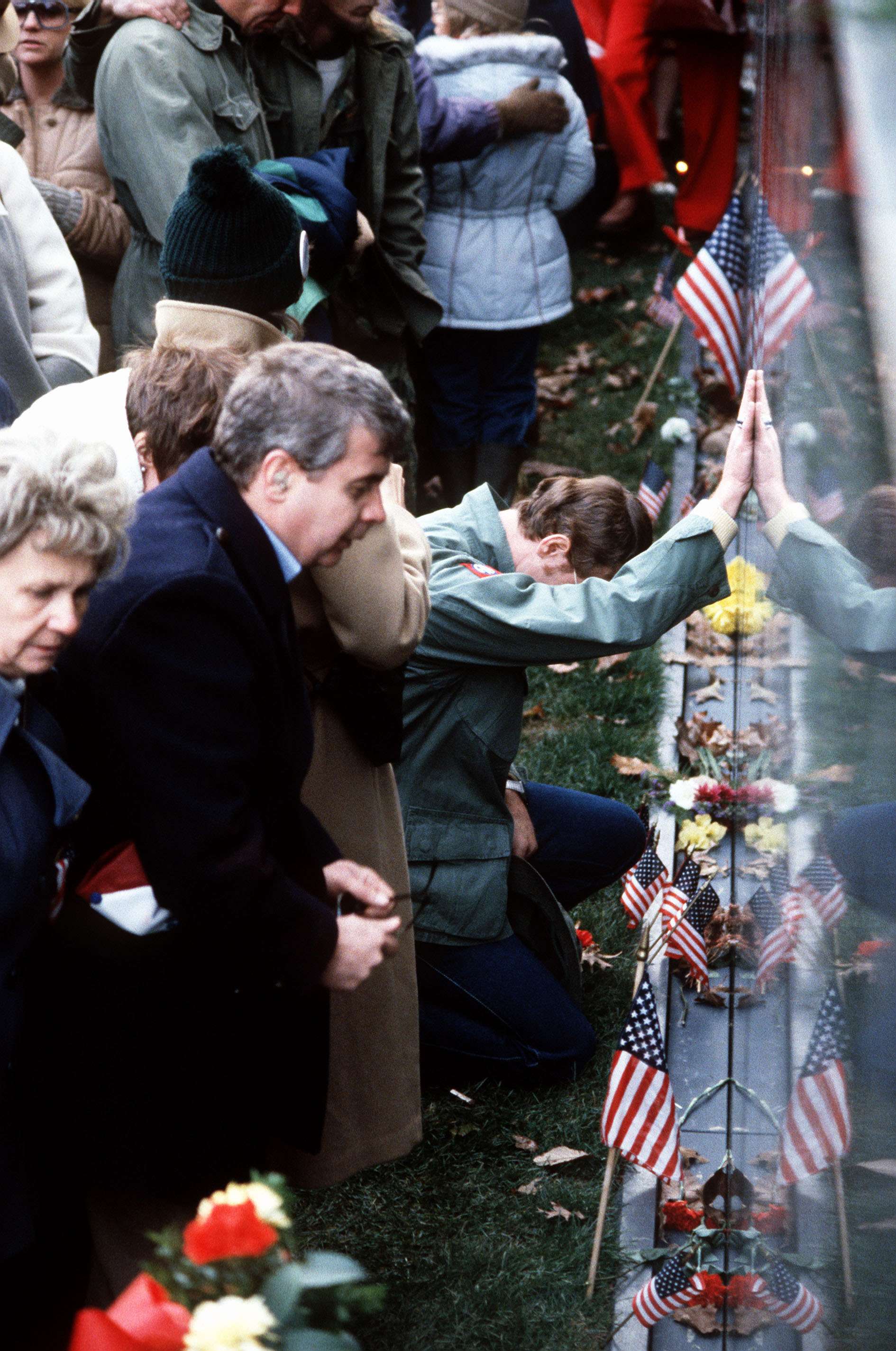U.S. Involvement in the Vietnam War
Making Connections
All documents and text associated with this activity are printed below, followed by a worksheet for student responses.Introduction
Why did the United States become involved in Vietnam? And why was it so polarizing for American society? U.S. involvement spanned six different presidential administrations. The war was long and costly. Over three million people were killed; 58,000 were Americans. It also divided Americans over their opinions about the war and the Government's trustworthiness.
Background:
During the Cold War, the U.S. Government feared that communism would spread and threaten democracy around the world. In Vietnam, the United States committed to battling communism financially at first, by supporting South Vietnam – who fought for Vietnam to be aligned with western allies like the United States. North Vietnam and the Communist organization in South Vietnam, the People's Liberation Armed Forces, fought for Vietnam to be a Communist state. Americans and their South Vietnamese allies referred to the People's Liberation Armed Forces as "insurgents" or "Viet Cong." U.S. military advisers were sent to Vietnam to train and support South Vietnamese troops. Eventually, as an ally to South Vietnam, the United States put troops on the ground to fight against North Vietnam and the People's Liberation Armed Forces.
Instructions:
This activity breaks the Vietnam War into episodes. Each one includes an information box and a document — your task is to name each episode. Read each information box and analyze the document that follows. Click "View Document Details" to read the full document and its description (and to listen to the memoir dictation). Then in the "Enter Your Response" box after each document, give that episode a title. For example, the title of the first episode could be "Truman Supports France Against North Vietnam."
This activity breaks the Vietnam War into episodes. Each one includes an information box and a document — your task is to name each episode. Read each information box and analyze the document that follows. Click "View Document Details" to read the full document and its description (and to listen to the memoir dictation). Then in the "Enter Your Response" box after each document, give that episode a title. For example, the title of the first episode could be "Truman Supports France Against North Vietnam."
Name:
Class:
Class:
Worksheet
U.S. Involvement in the Vietnam War
Making Connections
Examine the documents and text included in this activity. Fill in any blanks in the sequence with your thoughts and write your conclusion response in the space provided.The United States began its 25-year involvement in Vietnam at the end of World War II. France had ruled the colony of "French Indochina," including modern Vietnam, Cambodia, and Laos, for decades. After France fell to the Axis powers in World War II, Japan occupied the territory. As WWII came to a close and a Japanese surrender seemed likely, the Viet Minh — a communist-led organization dedicated to Vietnamese independence led by Ho Chi Minh — launched an uprising and declared Vietnam to be an independent state.
However, after WWII, France moved to regain control of the area, leading to war between France and the Democratic Republic of Vietnam (North Vietnam). From 1946–1950, the United States remained neutral. Then in 1950, President Truman authorized direct financial and military assistance to the French since the U.S. Government wanted France’s cooperation to stop the spread of communism in Europe.
However, after WWII, France moved to regain control of the area, leading to war between France and the Democratic Republic of Vietnam (North Vietnam). From 1946–1950, the United States remained neutral. Then in 1950, President Truman authorized direct financial and military assistance to the French since the U.S. Government wanted France’s cooperation to stop the spread of communism in Europe.
Photograph of President Truman and French President Charles de Gaulle During Welcoming Ceremonies on the White House Lawn, with Officers Saluting in the Background

Enter your response
The 1954 Geneva Accords settled the war between France and North Vietnam, called the First Indochina War. The agreement separated Vietnam at the 17th Parallel, creating a communist state in the North and a French-backed non-communist state in the south. It also called for an election in 1956 to reunify the two.
Then-President Eisenhower didn't want reunification to result in a Communist Vietnam. He believed "losing" South Vietnam to communism would be a strategic, economic, and humanitarian disaster. So he pledged support to an emerging leader—Ngo Dinh Diem—a devout Catholic and fervent anti-French, anti-communist nationalist. Diem faced multiple threats: some members of his inherited government and military were associated with the hated French; mobsters controlled much of Saigon; and French-supported armed religious sects and military officers challenged his leadership. Against all odds, Diem consolidated power.
Eisenhower’s decision to support Diem with supplies and military advisers was the beginning of U.S. involvement with the South Vietnamese government.
Then-President Eisenhower didn't want reunification to result in a Communist Vietnam. He believed "losing" South Vietnam to communism would be a strategic, economic, and humanitarian disaster. So he pledged support to an emerging leader—Ngo Dinh Diem—a devout Catholic and fervent anti-French, anti-communist nationalist. Diem faced multiple threats: some members of his inherited government and military were associated with the hated French; mobsters controlled much of Saigon; and French-supported armed religious sects and military officers challenged his leadership. Against all odds, Diem consolidated power.
Eisenhower’s decision to support Diem with supplies and military advisers was the beginning of U.S. involvement with the South Vietnamese government.
Communism Means Terrorism
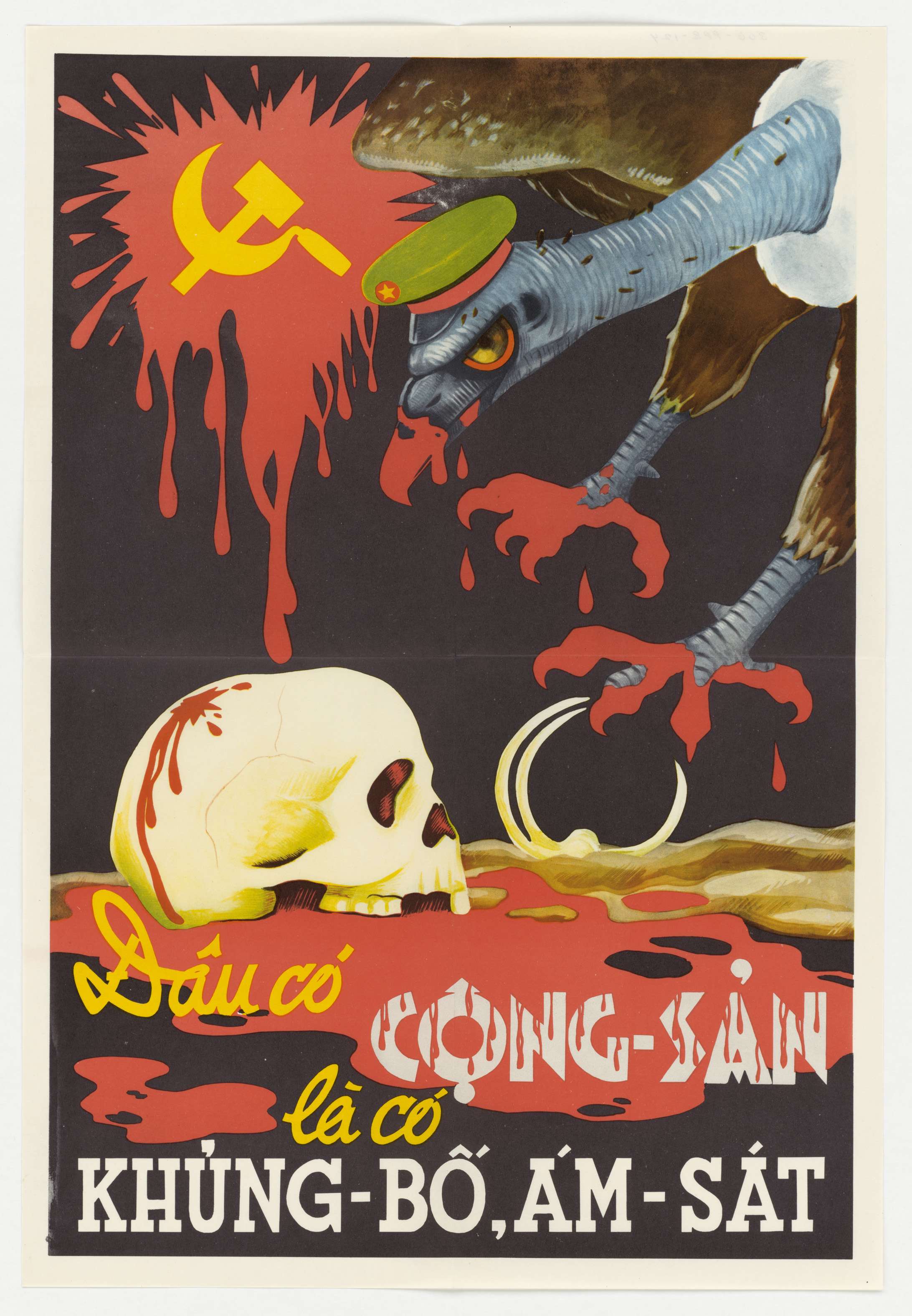
Enter your response
When Kennedy became President, he told a reporter: "Vietnam is the place" for a win. His administration had experienced the Bay of Pigs defeat in Cuba and the construction of the Berlin Wall in 1961. He was convinced the United States could restore its Cold War credibility by saving Vietnam from communism.
The Diem government faced attacks from within South Vietnam from Communist insurgents (the People’s Liberation Armed Forces) in rural areas. Kennedy supplied thousands of additional military advisers and equipment to South Vietnam to fight the Communist insurgents. He resisted sending ground troops, however, against his advisers’ persistent urging.
Additionally, protests grew within South Vietnam against the increasingly unpopular Diem regime; but Diem ignored U.S. calls for reform. The United States offered support when a group of generals plotted a coup d’état. Diem was overthrown and assassinated. Kennedy was ambivalent about abandoning Diem, and knew it would anger members of Congress, but said they would "be madder if Vietnam goes down the drain."
The Diem government faced attacks from within South Vietnam from Communist insurgents (the People’s Liberation Armed Forces) in rural areas. Kennedy supplied thousands of additional military advisers and equipment to South Vietnam to fight the Communist insurgents. He resisted sending ground troops, however, against his advisers’ persistent urging.
Additionally, protests grew within South Vietnam against the increasingly unpopular Diem regime; but Diem ignored U.S. calls for reform. The United States offered support when a group of generals plotted a coup d’état. Diem was overthrown and assassinated. Kennedy was ambivalent about abandoning Diem, and knew it would anger members of Congress, but said they would "be madder if Vietnam goes down the drain."
John F. Kennedy Memoir Dictation
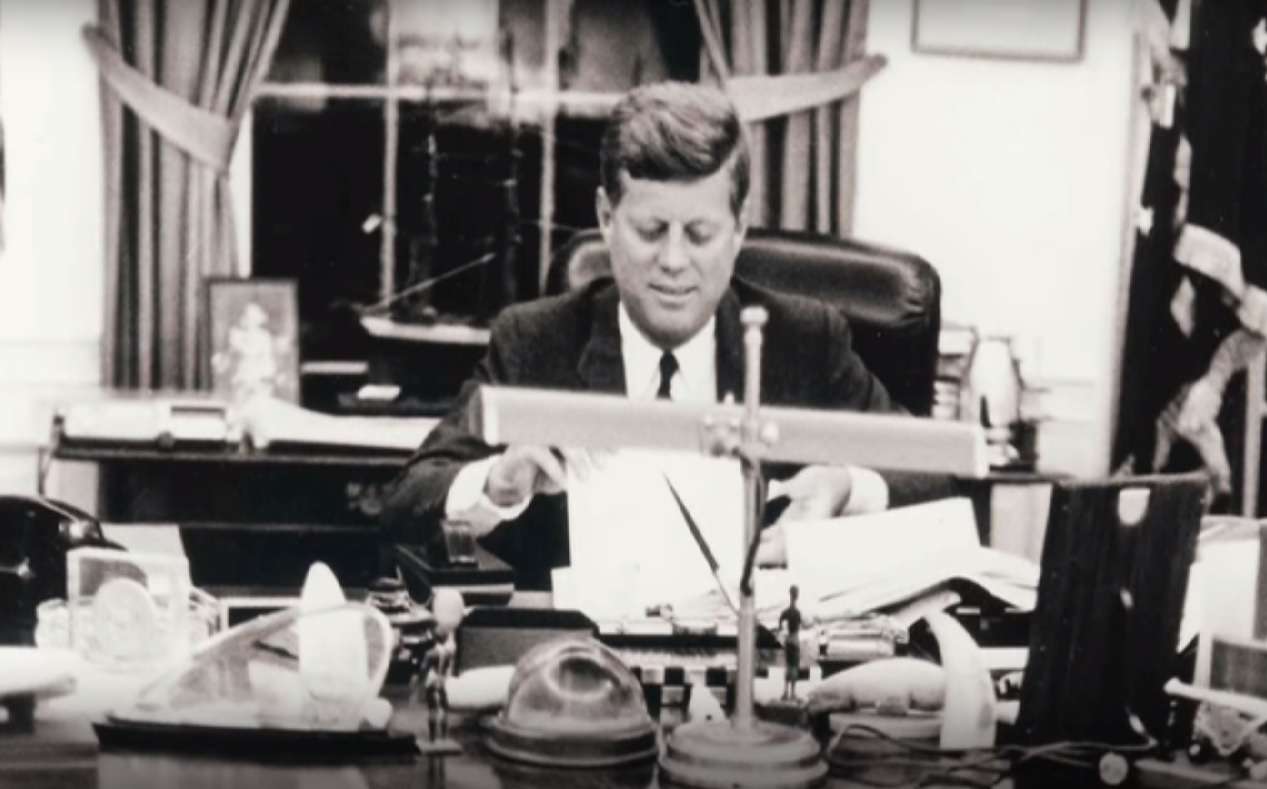
Enter your response
South Vietnam was in political chaos after the coup. North Vietnam escalated the war in hopes of bringing Communists to power before America fully intervened. Despite doubts about its significance and winnability, President Johnson said he was "not going to lose Vietnam."
In August 1964, President Johnson announced on TV that American ships had been attacked twice in international waters in the Gulf of Tonkin near North Vietnam. Congress quickly passed the Tonkin Gulf Resolution, giving Johnson unprecedented power to "take all necessary measures to repel any armed attack against the forces of the United States and to prevent further aggression."
When contrary information about the Gulf of Tonkin incidents surfaced — the ship USS Maddox had been conducting electronic eavesdropping on North Vietnam to assist South Vietnamese Army raids on North Vietnamese targets — many believed Congress had been conned.
In August 1964, President Johnson announced on TV that American ships had been attacked twice in international waters in the Gulf of Tonkin near North Vietnam. Congress quickly passed the Tonkin Gulf Resolution, giving Johnson unprecedented power to "take all necessary measures to repel any armed attack against the forces of the United States and to prevent further aggression."
When contrary information about the Gulf of Tonkin incidents surfaced — the ship USS Maddox had been conducting electronic eavesdropping on North Vietnam to assist South Vietnamese Army raids on North Vietnamese targets — many believed Congress had been conned.
Joint Resolution of August 10, 1964, Public Law 88-408, 78 STAT 384, to Promote the Maintenance of International Peace and Security in Southeast Asia
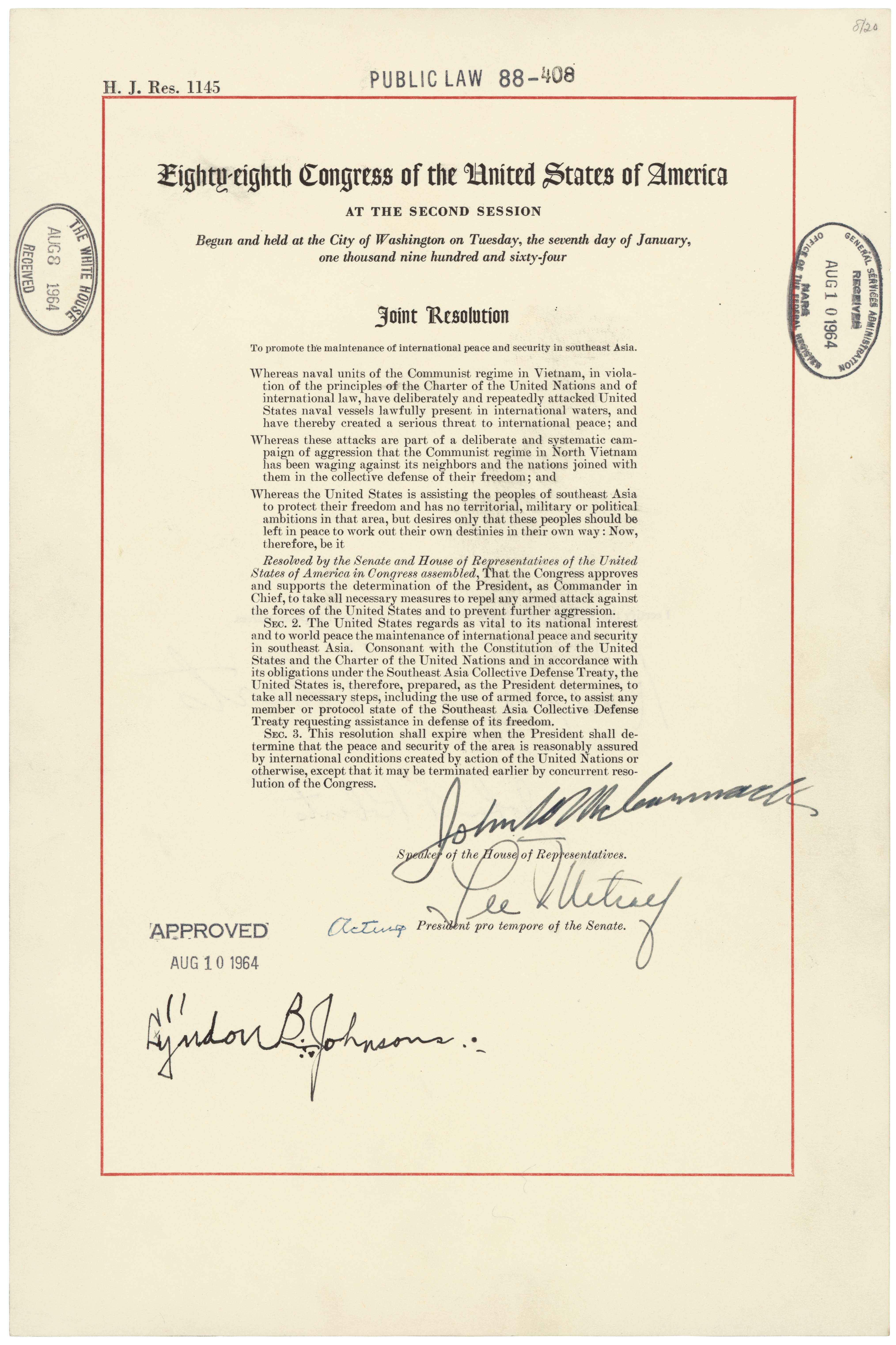
Enter your response
President Johnson planned a course of gradual involvement in Vietnam that he hoped would avoid public scrutiny. Though his advisers predicted "disastrous defeat," he was intent on proving his and America’s "credibility."
Early in 1965, Communist forces attacked a U.S. Army airfield in South Vietnam. This gave the Johnson administration a reason to launch Operation Rolling Thunder, a sustained bombing campaign against North Vietnam. The planned air strikes created a need for an air base with protection. So, the first American ground troops arrived soon after the bombing began. Hundreds of thousands of U.S. combat troops followed. America was at war.
Within a year, 175,000 American troops were in Vietnam. U.S. bombers dropped 643,000 tons of bombs between 1965 and 1968 during Operation Rolling, killing approximately 52,000 Vietnamese civilians.
Early in 1965, Communist forces attacked a U.S. Army airfield in South Vietnam. This gave the Johnson administration a reason to launch Operation Rolling Thunder, a sustained bombing campaign against North Vietnam. The planned air strikes created a need for an air base with protection. So, the first American ground troops arrived soon after the bombing began. Hundreds of thousands of U.S. combat troops followed. America was at war.
Within a year, 175,000 American troops were in Vietnam. U.S. bombers dropped 643,000 tons of bombs between 1965 and 1968 during Operation Rolling, killing approximately 52,000 Vietnamese civilians.
Memo from McGeorge Bundy to President Lyndon B Johnson

Enter your response
Back in the United States, antiwar protests intensified. Public support for the war fell below 50 percent for the first time. In October 1967, nearly 100,000 people joined the March on the Pentagon to protest the war. The White House tried to fight dissent with news of progress. Military officers were pressured to overestimate enemy casualties and underestimate enemy strength. The Johnson administration even called General Westmoreland, commander of the U.S. military in Vietnam, home from the battlefield to present a glowing report to the American people.
In Vietnam, the American strategy was to suppress the Communist insurgency through the ground war while winning the hearts and minds of the South Vietnamese people through humanitarian efforts. But it was difficult to gain support when combat forces were using search-and-destroy tactics to look for insurgents, upending the villages and lives of the South Vietnamese. And the U.S. State Department concluded that, while North Vietnam was supporting the Communists in South Vietnam, most of the Communist insurgents were coming from the South Vietnamese population itself.
America seemed to be fighting on three fronts: 1) militarily against North Vietnam, 2) convincing people in South Vietnam to support U.S. efforts, and 3) dealing with new levels of antiwar activism at home.
In Vietnam, the American strategy was to suppress the Communist insurgency through the ground war while winning the hearts and minds of the South Vietnamese people through humanitarian efforts. But it was difficult to gain support when combat forces were using search-and-destroy tactics to look for insurgents, upending the villages and lives of the South Vietnamese. And the U.S. State Department concluded that, while North Vietnam was supporting the Communists in South Vietnam, most of the Communist insurgents were coming from the South Vietnamese population itself.
America seemed to be fighting on three fronts: 1) militarily against North Vietnam, 2) convincing people in South Vietnam to support U.S. efforts, and 3) dealing with new levels of antiwar activism at home.
Public Reactions: The March on the Pentagon

Enter your response
On January 31, 1968, the South Vietnamese were looking forward to Tet, a celebration of the lunar new year. They were caught off guard when 70,000 Communist troops attacked more than 100 towns and cities with sudden brutality and violence – the beginning of what became known as the Tet Offensive. Most of the fighting was over in a few days, but a second wave came in late April and a third in August.
Although the Communists suffered devastating casualties and their attempt to spark a general uprising completely failed, many Americans concluded the United States and its allies had suffered a massive defeat. When a Defense Department report regarding the need for 205,000 more American troops was leaked to the New York Times, Americans concluded the war was at a standstill and the Johnson administration had lied to them.
The administration began to question its strategy in Vietnam. President Johnson gave a speech on March 31, 1968, calling for a halt to bombing, greater reliance on the South Vietnamese, and a modest troop increase. In April, North Vietnam agreed to open peace talks.
Although the Communists suffered devastating casualties and their attempt to spark a general uprising completely failed, many Americans concluded the United States and its allies had suffered a massive defeat. When a Defense Department report regarding the need for 205,000 more American troops was leaked to the New York Times, Americans concluded the war was at a standstill and the Johnson administration had lied to them.
The administration began to question its strategy in Vietnam. President Johnson gave a speech on March 31, 1968, calling for a halt to bombing, greater reliance on the South Vietnamese, and a modest troop increase. In April, North Vietnam agreed to open peace talks.
President Lyndon B. Johnson Speech Regarding Bombing Halt and Decision Not to Run for Re-election
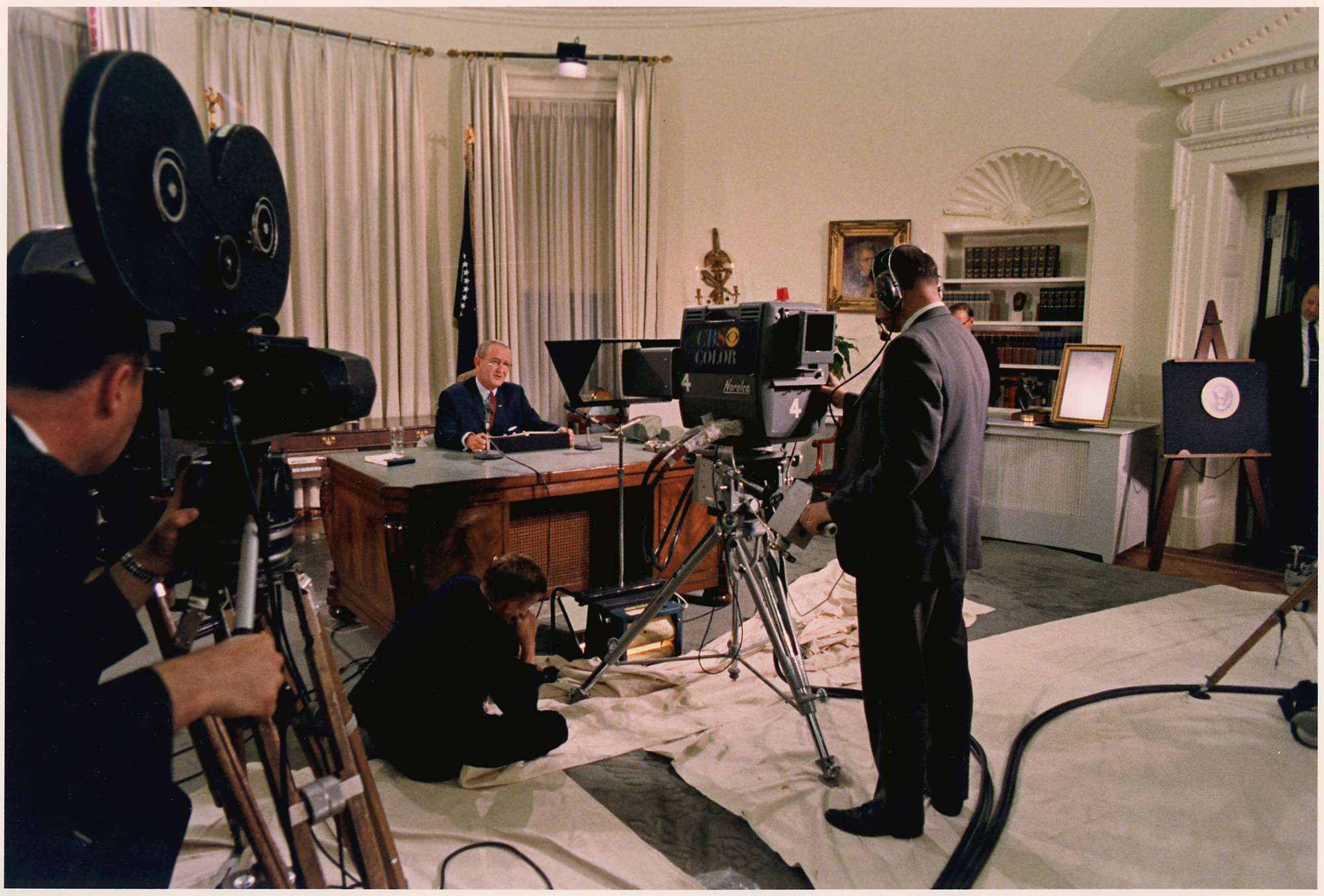
Enter your response
Richard Nixon’s Presidential campaign advocated bringing the war to an honorable end. However, President Johnson had received a tip that the Nixon campaign was attempting to interfere with the peace negotiations. He ordered surveillance on the South Vietnam Embassy and on Anna Chennault, a fundraiser for Nixon’s campaign. Controversy remains, but documents from the time lend weight to the argument that candidate Nixon played a direct role in obstructing a peace agreement.
Once elected, President Nixon announced his plan for "Vietnamization" – increasingly turning the war over to the South Vietnamese. After millions demonstrated in the Moratorium to End the War in Vietnam in late 1969, he asked "the great silent majority" of Americans for their support. He escalated the bombing and expanded the war in Cambodia and Laos. The war continued for four years, during which 21,041 Americans and over 2 million Vietnamese, Cambodians, and Laotians were killed.
Once elected, President Nixon announced his plan for "Vietnamization" – increasingly turning the war over to the South Vietnamese. After millions demonstrated in the Moratorium to End the War in Vietnam in late 1969, he asked "the great silent majority" of Americans for their support. He escalated the bombing and expanded the war in Cambodia and Laos. The war continued for four years, during which 21,041 Americans and over 2 million Vietnamese, Cambodians, and Laotians were killed.
H. R. Haldeman’s Notes
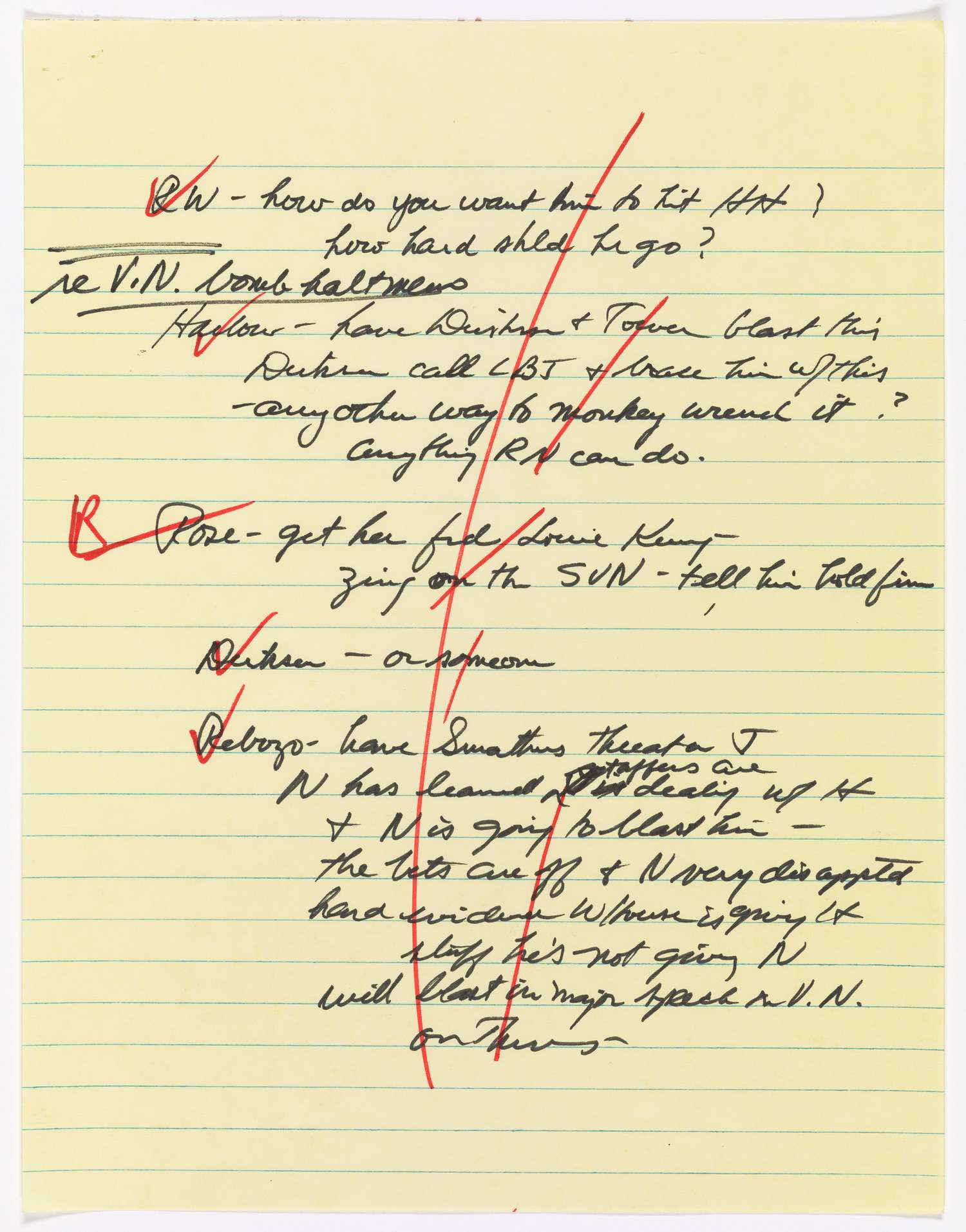
Enter your response
In a coup strongly encouraged by the United States, a U.S.-friendly government came to power in Cambodia. The Vietnamese Communists used neutral Cambodia as a place to regroup and store weapons. President Nixon planned to send ground troops to Cambodia to attack Communist sanctuaries and central headquarters. There is speculation that Nixon hoped to destabilize the enemy in order to provide a "decent interval" in which South Vietnam could fend for itself while American troops pulled out.
Nixon televised his decision to initiate the Cambodian campaign. This apparent expansion of the war increased antiwar activity that escalated to a national crisis when four students were shot at a protest in Ohio at Kent State University. The public was unaware that Nixon had been secretly bombing Cambodia since mid-March 1969—an increased continuation of a covert bombing campaign started by Johnson in 1965.
Nixon televised his decision to initiate the Cambodian campaign. This apparent expansion of the war increased antiwar activity that escalated to a national crisis when four students were shot at a protest in Ohio at Kent State University. The public was unaware that Nixon had been secretly bombing Cambodia since mid-March 1969—an increased continuation of a covert bombing campaign started by Johnson in 1965.
Campus Scene, Kent State University (OH)

Enter your response
In February 1970, Secretary of State Henry Kissinger began negotiations with North Vietnam. Hoping to gain an edge in these deliberations, North Vietnam attacked South Vietnam in March. Nixon was enraged by the "Spring Offensive." It threatened his reelection and his budding relationship with the People's Republic of China and the Soviet Union, countries he hoped might abandon North Vietnam for the promise of improved American relations. In a recorded conversation, he told Kissinger he would retaliate by bombing "the bastards like [they'd] never been bombed before."
In October, a defeated North Vietnam made concessions and Kissinger announced "peace is at hand." But South Vietnamese President Thieu balked at the agreement and demanded changes. When Kissinger attempted to renegotiate, the talks collapsed. Nixon blamed North Vietnam and ordered a massive "Christmas Bombing" to bring both sides back to the table.
In October, a defeated North Vietnam made concessions and Kissinger announced "peace is at hand." But South Vietnamese President Thieu balked at the agreement and demanded changes. When Kissinger attempted to renegotiate, the talks collapsed. Nixon blamed North Vietnam and ordered a massive "Christmas Bombing" to bring both sides back to the table.
Text of Letter from President Nixon to President Thieu

Enter your response
North Vietnam returned to the negotiating table. On January 27, 1973, the Paris Peace Accords officially ended the war in Vietnam. The final agreement was only superficially different from the draft reached in October 1972 before the "Christmas Bombing." South Vietnamese President Thieu reluctantly signed after Nixon secretly promised "swift and severe retaliatory action" if North Vietnam violated it. Nixon and Kissinger declared they had achieved "peace with honor" and hoped it would last long enough to give South Vietnam a fighting chance.
In fact the war was far from over. Fighting between North and South continued and even increased in places. North Vietnam began preparations to overtake the South. President Nixon, embroiled in the Watergate scandal, could not provide the backup he had promised.
In fact the war was far from over. Fighting between North and South continued and even increased in places. North Vietnam began preparations to overtake the South. President Nixon, embroiled in the Watergate scandal, could not provide the backup he had promised.
Multilateral Agreement between the United States, Democratic Republic of Vietnam, Republic of Vietnam, and Provisional Revolutionary Government of Vietnam (English)

Enter your response
The Communists continued to infiltrate South Vietnam. The 1973 Case-Church Amendment prohibited U.S. military activity in Vietnam, Laos, and Cambodia without Congressional approval; though the United States continued to supply its ally with some military equipment and arms.
North Vietnamese Army forces attacked major cities in March 1975 and the South Vietnamese Army crumbled. President Ford requested additional aid from Congress, which was not approved. His persistence had a symbolic purpose. It strengthened U.S. credibility and allowed his administration to blame Congress for South Vietnam’s fall.
On April 28, 1975, Ford ordered a last-minute evacuation of the last American civilians and South Vietnamese citizens who were at risk of retaliation by the Communists. The evacuation ended just hours before a North Vietnamese Army tank crashed the Imperial Palace gates in Saigon on April 30th – the Fall of Saigon and the end to the war. North Vietnam took over. In the years that followed, a total of 1.6 million Vietnamese refugees fled the Communist regime.
North Vietnamese Army forces attacked major cities in March 1975 and the South Vietnamese Army crumbled. President Ford requested additional aid from Congress, which was not approved. His persistence had a symbolic purpose. It strengthened U.S. credibility and allowed his administration to blame Congress for South Vietnam’s fall.
On April 28, 1975, Ford ordered a last-minute evacuation of the last American civilians and South Vietnamese citizens who were at risk of retaliation by the Communists. The evacuation ended just hours before a North Vietnamese Army tank crashed the Imperial Palace gates in Saigon on April 30th – the Fall of Saigon and the end to the war. North Vietnam took over. In the years that followed, a total of 1.6 million Vietnamese refugees fled the Communist regime.
Telegram from Ambassador Graham Martin Concerning the Evacuation of Saigon, South Vietnam
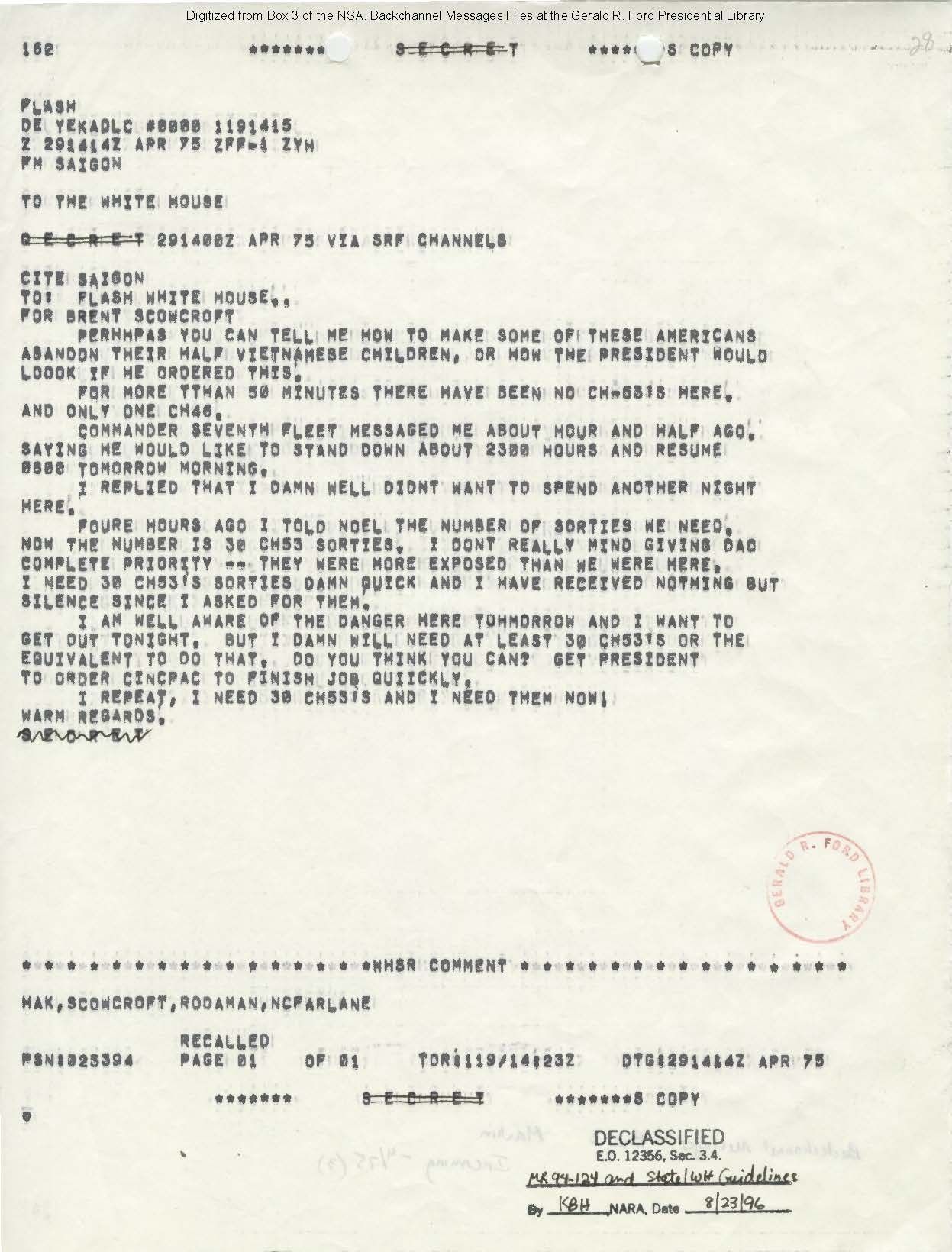
Enter your response
Almost a decade after the war ended, Americans who served were honored with the Vietnam Veterans Memorial in Washington, DC. "The Wall that Heals" was dedicated in 1982. After years of fundraising, Congressional legislation, and arguments over its design, Vietnam veteran Jan C. Scruggs realized his dream of a monument, not to the war, but to those who fought it. The names of more than 58,000 Americans who gave their lives are inscribed upon it.
In 1995, President Clinton announced the normalization of relations between the United States and Vietnam. Today, the United States and Vietnam recognize that there is no conflict, and that there are issues upon which the two countries can work together.
In 1995, President Clinton announced the normalization of relations between the United States and Vietnam. Today, the United States and Vietnam recognize that there is no conflict, and that there are issues upon which the two countries can work together.
Visitors search for names on the face of the Vietnam Veterans Memorial after its official dedication

Enter your response
1
Activity Element
Photograph of President Truman and French President Charles de Gaulle During Welcoming Ceremonies on the White House Lawn, with Officers Saluting in the Background
Page 1

2
Activity Element
Communism Means Terrorism
Page 1

3
Activity Element
John F. Kennedy Memoir Dictation
Page 1

4
Activity Element
Joint Resolution of August 10, 1964, Public Law 88-408, 78 STAT 384, to Promote the Maintenance of International Peace and Security in Southeast Asia
Page 1

5
Activity Element
Memo from McGeorge Bundy to President Lyndon B Johnson
Page 1

6
Activity Element
Public Reactions: The March on the Pentagon
Page 1

7
Activity Element
President Lyndon B. Johnson Speech Regarding Bombing Halt and Decision Not to Run for Re-election
Page 1

8
Activity Element
H. R. Haldeman’s Notes
Page 2

9
Activity Element
Campus Scene, Kent State University (OH)
Page 1

10
Activity Element
Text of Letter from President Nixon to President Thieu
Page 1

11
Activity Element
Multilateral Agreement between the United States, Democratic Republic of Vietnam, Republic of Vietnam, and Provisional Revolutionary Government of Vietnam (English)
Page 1

12
Activity Element
Telegram from Ambassador Graham Martin Concerning the Evacuation of Saigon, South Vietnam
Page 1

13
Activity Element
Visitors search for names on the face of the Vietnam Veterans Memorial after its official dedication
Page 1

Conclusion
U.S. Involvement in the Vietnam War
Making Connections
Look back at the titles that you gave the episodes — you have essentially created a sequence of events covering U.S. involvement in Vietnam.Answer the following questions in preparation for a class discussion:
- Why was America involved in the Vietnam War?
- Why do you think the Vietnam War was so divisive for America?
- Did you expect the war to end earlier than it did? If so, after what episode and why didn't it?
- If you were the U.S. President, would you have done things differently?
Your Response
Document
Photograph of President Truman and French President Charles de Gaulle During Welcoming Ceremonies on the White House Lawn, with Officers Saluting in the Background
8/22/1945
This photograph shows President Harry S. Truman and French President Charles de Gaulle during welcoming ceremonies on the White House lawn, with officers saluting in the background.
In this official visit to Washington in 1945, French President Charles de Gaulle thanked the United States for its help liberating France from German occupation during World War II.
During the visit, Truman told de Gaulle that the U.S. would not oppose a return of French authority in Indochina. And when France went to war to recolonize Vietnam in 1945, the U.S. government needed its ally’s cooperation to contain the spread of communism in Europe.
From 1946 to 1950, the United States adopted a neutral policy toward the conflict. In 1950 President Harry S. Truman authorized direct financial and military assistance to the French.
In this official visit to Washington in 1945, French President Charles de Gaulle thanked the United States for its help liberating France from German occupation during World War II.
During the visit, Truman told de Gaulle that the U.S. would not oppose a return of French authority in Indochina. And when France went to war to recolonize Vietnam in 1945, the U.S. government needed its ally’s cooperation to contain the spread of communism in Europe.
From 1946 to 1950, the United States adopted a neutral policy toward the conflict. In 1950 President Harry S. Truman authorized direct financial and military assistance to the French.
This primary source comes from the Collection HST-AVC: Audiovisual Collection.
National Archives Identifier: 199186
Full Citation: Photograph of President Truman and French President Charles de Gaulle During Welcoming Ceremonies on the White House Lawn, with Officers Saluting in the Background; 8/22/1945; Photographs Relating to the Administration, Family, and Personal Life of Harry S. Truman, 1957 - 2004; Collection HST-AVC: Audiovisual Collection, ; Harry S. Truman Library, Independence, MO. [Online Version, https://www.docsteach.org/documents/document/truman-gaulle-welcoming-ceremonies, April 20, 2024]Photograph of President Truman and French President Charles de Gaulle During Welcoming Ceremonies on the White House Lawn, with Officers Saluting in the Background
Page 1
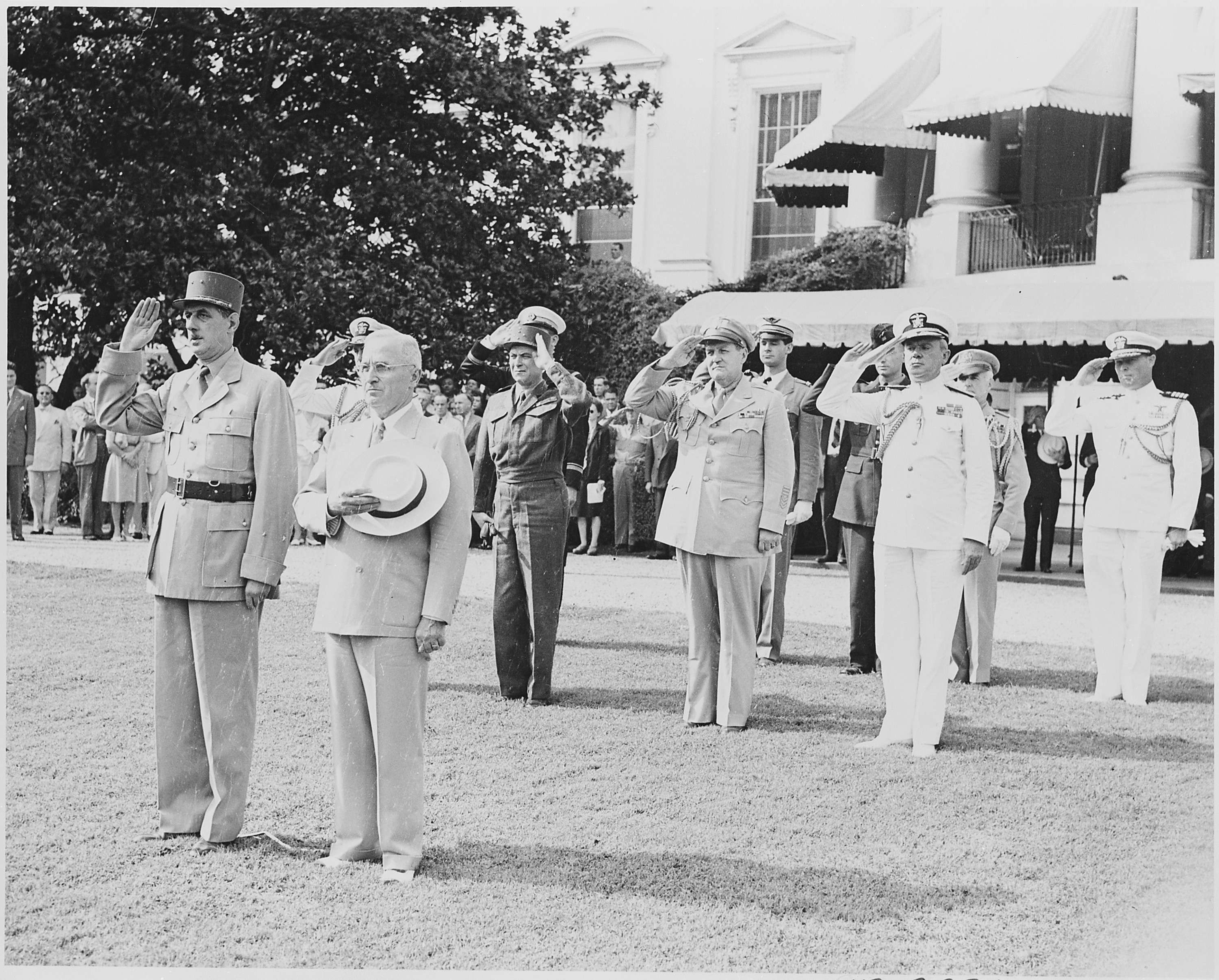
Document
Communism Means Terrorism
9/15/1954
This poster, created and distributed internationally by the United States Information Agency (USIA), says "Anywhere there is communism, there is terrorism and assassination!"
It was designed to amplify fear of communism in a newly divided Vietnam. Earlier in 1954, the Geneva Accords had called for a temporary partition of Vietnam at the 17th Parallel—creating a communist state in the North and a French-backed non-communist state in the South.
A series of events intensified the "Red Scare" that gripped Americans in the 1940s and 50s. In 1949 the Soviet Union successfully tested an atomic bomb. Chinese Communists formed the People’s Republic of China that same year. North Korea invaded South Korea the next. Many interpreted these events as evidence of a global Communist plot.
USIA posters were designed to promote U.S. values; to expose alleged Communist falsehoods, threats, and crimes; and to strengthen understanding of and support for U.S. objectives in the Cold War.
It was designed to amplify fear of communism in a newly divided Vietnam. Earlier in 1954, the Geneva Accords had called for a temporary partition of Vietnam at the 17th Parallel—creating a communist state in the North and a French-backed non-communist state in the South.
A series of events intensified the "Red Scare" that gripped Americans in the 1940s and 50s. In 1949 the Soviet Union successfully tested an atomic bomb. Chinese Communists formed the People’s Republic of China that same year. North Korea invaded South Korea the next. Many interpreted these events as evidence of a global Communist plot.
USIA posters were designed to promote U.S. values; to expose alleged Communist falsehoods, threats, and crimes; and to strengthen understanding of and support for U.S. objectives in the Cold War.
This primary source comes from the Records of the U.S. Information Agency.
National Archives Identifier: 6948996
Full Citation: Poster 306-PPB-124; Communism Means Terrorism; 9/15/1954; Propaganda Posters Distributed in Asia, Latin America and the Middle East, ca. 1950 - ca. 1965; Records of the U.S. Information Agency, ; National Archives at College Park, College Park, MD. [Online Version, https://www.docsteach.org/documents/document/communism-terrorism, April 20, 2024]Communism Means Terrorism
Page 1
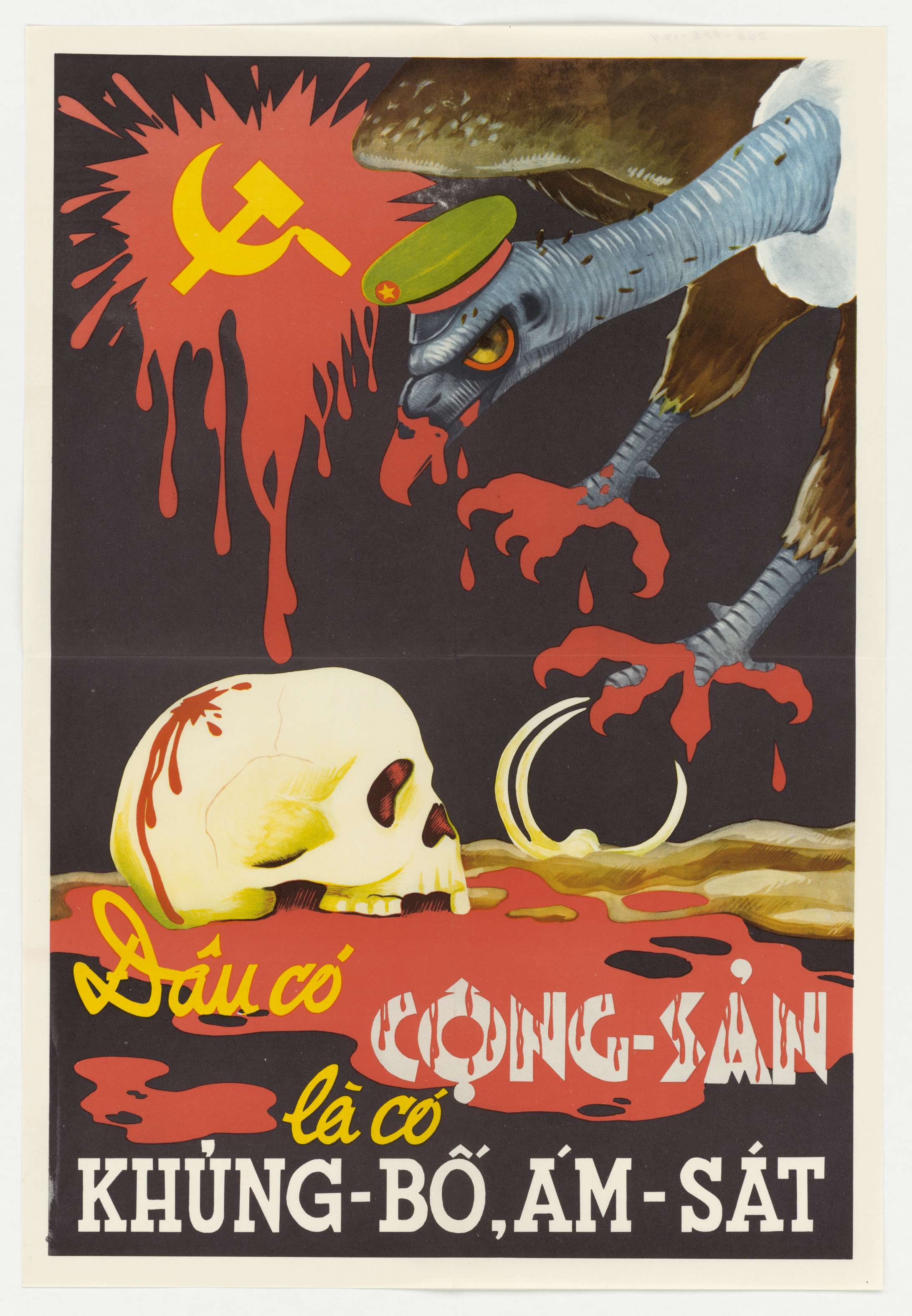
Document
John F. Kennedy Memoir Dictation
11/4/1963
This is a sound recording of President John F. Kennedy dictating a memoir entry in November 1963. He talks about the coup in Saigon, South Vietnam, and the assassinations of President Ngo Dinh Diem and his brother Ngo Dinh Nhu. President Kennedy is interrupted by his son, John F. Kennedy, Jr. — the light tone he strikes with his son stands in stark contrast to his words about the overthrow of Diem and his brother, which clearly upset him. This was just a few weeks before President Kennedy's assasination.
This primary source comes from the Collection JFK-3: Papers of John F. Kennedy: Presidential Papers: President's Office Files.
Full Citation: Sound Recording JFKPOF-TPH-52-1; John F. Kennedy Memoir Dictation; 11/4/1963; Telephone Recordings, ca. 1/1962 - 11/1963; Collection JFK-3: Papers of John F. Kennedy: Presidential Papers: President's Office Files, ; John F. Kennedy Library, Boston, MA. [Online Version, https://www.docsteach.org/documents/document/john-f-kennedy-memoir-dictation, April 20, 2024]John F. Kennedy Memoir Dictation
Page 1
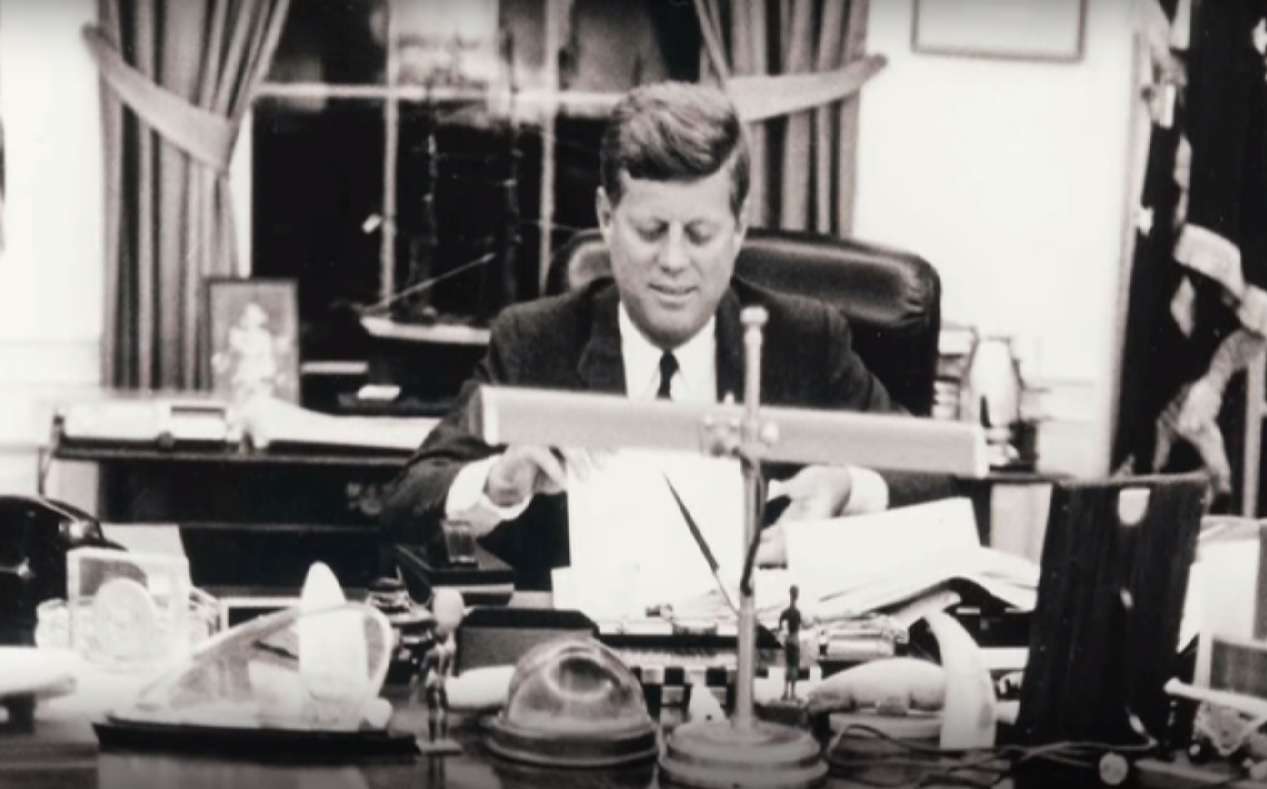
Document
Joint Resolution of August 10, 1964, Public Law 88-408, 78 STAT 384, to Promote the Maintenance of International Peace and Security in Southeast Asia
8/10/1964
This is Public Law 88-408, Joint Resolution for the Maintenance of Peace and Security in Southeast Asia, that was passed by Congress and signed by President Lyndon B. Johnson. This is a "ceremonial copy" of the Public Law from the Lyndon B. Johnson Museum Collection.
Congress passed the Tonkin Gulf Resolution with the understanding that U.S. ships had been attacked twice in international waters in the Gulf of Tonkin near North Vietnam. They gave Johnson unprecedented power to “take all necessary measures to repel any armed attack against the forces of the United States and to prevent further aggression.”
There was little debate as legislators considered two incidents that had happened in the preceding days. On August 2 – the first Tonkin Gulf incident – North Vietnamese torpedo boats were spotted and attacked the destroyer USS Maddox. The Maddox was conducting electronic eavesdropping on North Vietnam to assist South Vietnamese Army (ARVN) commando raids on North Vietnamese targets, but that wasn't publicly known at the time. Historians now suspect the North Vietnamese boats had set out to attack an ARVN raid in progress when it encountered the Maddox.
On August 4, the USS Maddox captain reported a second incident, that he was “under continuous torpedo attack.” He later cabled “freak weather effects on radar and overeager sonarmen may have accounted for many reports,” but Defense Secretary Robert McNamara did not report the captain’s doubts to President Johnson. (A 2002 National Security Agency report made available in 2007 confirmed the August 2 attack, but concluded the August 4 attack never happened.)
Johnson portrayed confrontations between U.S. and North Vietnamese ships off the coast of North Vietnam as unprovoked aggression. When contrary information surfaced, many believed Congress had been conned. It was too late.
The Gulf of Tonkin act became more controversial as opposition to the war mounted. A Senate investigation revealed that the Maddox had been on an intelligence mission in Tonkin Gulf, contradicting Johnson’s denial of U.S. Navy support of such missions. The Resolution was repealed in 1971 in an attempt to curtail President Nixon’s power to continue the war.
Congress passed the Tonkin Gulf Resolution with the understanding that U.S. ships had been attacked twice in international waters in the Gulf of Tonkin near North Vietnam. They gave Johnson unprecedented power to “take all necessary measures to repel any armed attack against the forces of the United States and to prevent further aggression.”
There was little debate as legislators considered two incidents that had happened in the preceding days. On August 2 – the first Tonkin Gulf incident – North Vietnamese torpedo boats were spotted and attacked the destroyer USS Maddox. The Maddox was conducting electronic eavesdropping on North Vietnam to assist South Vietnamese Army (ARVN) commando raids on North Vietnamese targets, but that wasn't publicly known at the time. Historians now suspect the North Vietnamese boats had set out to attack an ARVN raid in progress when it encountered the Maddox.
On August 4, the USS Maddox captain reported a second incident, that he was “under continuous torpedo attack.” He later cabled “freak weather effects on radar and overeager sonarmen may have accounted for many reports,” but Defense Secretary Robert McNamara did not report the captain’s doubts to President Johnson. (A 2002 National Security Agency report made available in 2007 confirmed the August 2 attack, but concluded the August 4 attack never happened.)
Johnson portrayed confrontations between U.S. and North Vietnamese ships off the coast of North Vietnam as unprovoked aggression. When contrary information surfaced, many believed Congress had been conned. It was too late.
The Gulf of Tonkin act became more controversial as opposition to the war mounted. A Senate investigation revealed that the Maddox had been on an intelligence mission in Tonkin Gulf, contradicting Johnson’s denial of U.S. Navy support of such missions. The Resolution was repealed in 1971 in an attempt to curtail President Nixon’s power to continue the war.
Transcript
Eighty-eighth Congress of the United States of AmericaAT THE SECOND SESSION
Begun and held at the City of Washington on Tuesday, the seventh day of January, one thousand nine hundred and sixty-four
Joint Resolution
To promote the maintenance of international peace and security in southeast Asia.
Whereas naval units of the Communist regime in Vietnam, in violation of the principles of the Charter of the United Nations and of international law, have deliberately and repeatedly attacked United States naval vessels lawfully present in international waters, and have thereby created a serious threat to international peace; and
Whereas these attackers are part of deliberate and systematic campaign of aggression that the Communist regime in North Vietnam has been waging against its neighbors and the nations joined with them in the collective defense of their freedom; and
Whereas the United States is assisting the peoples of southeast Asia to protest their freedom and has no territorial, military or political ambitions in that area, but desires only that these people should be left in peace to work out their destinies in their own way: Now, therefore be it
Resolved by the Senate and House of Representatives of the United States of America in Congress assembled, That the Congress approves and supports the determination of the President, as Commander in Chief, to take all necessary measures to repel any armed attack against the forces of the United States and to prevent further aggression.
Section 2. The United States regards as vital to its national interest and to world peace the maintenance of international peace and security in southeast Asia. Consonant with the Constitution of the United States and the Charter of the United Nations and in accordance with its obligations under the Southeast Asia Collective Defense Treaty, the United States is, therefore, prepared, as the President determines, to take all necessary steps, including the use of armed force, to assist any member or protocol state of the Southeast Asia Collective Defense Treaty requesting assistance in defense of its freedom.
Section 3. This resolution shall expire when the President shall determine that the peace and security of the area is reasonably assured by international conditions created by action of the United Nations or otherwise, except that it may be terminated earlier by concurrent resolution of the Congress.
[endorsements]
This primary source comes from the General Records of the United States Government.
National Archives Identifier: 2803448
Full Citation: Joint Resolution of August 10, 1964, Public Law 88-408, 78 STAT 384, to Promote the Maintenance of International Peace and Security in Southeast Asia; 8/10/1964; Enrolled Acts and Resolutions of Congress, 1789 - 2011; General Records of the United States Government, ; National Archives Building, Washington, DC. [Online Version, https://www.docsteach.org/documents/document/tonkin-gulf-resolution, April 20, 2024]Joint Resolution of August 10, 1964, Public Law 88-408, 78 STAT 384, to Promote the Maintenance of International Peace and Security in Southeast Asia
Page 1
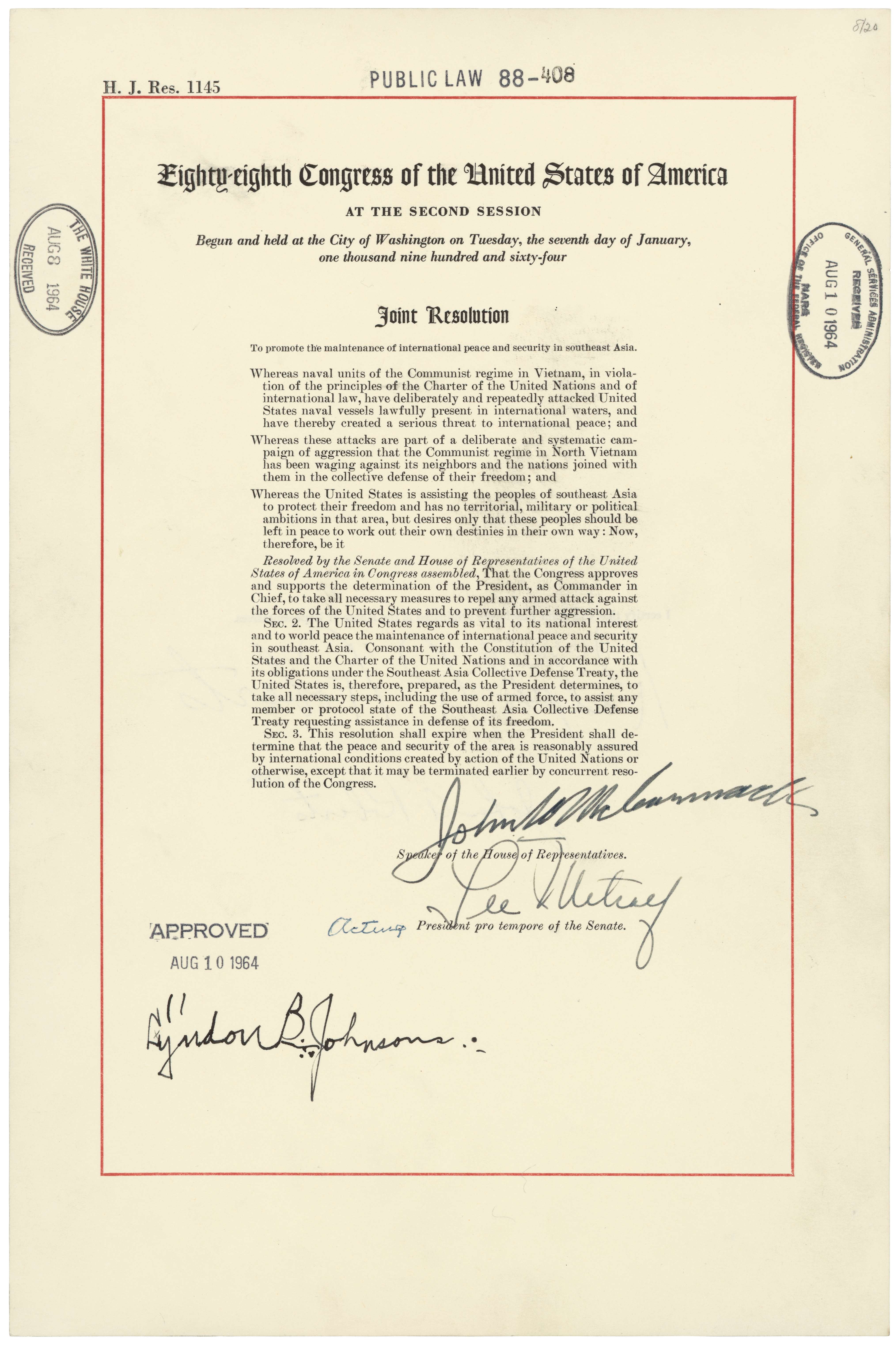
Document
Memo from McGeorge Bundy to President Lyndon B Johnson
1/27/1965
Assistant National Security Adviser McGeorge Bundy and Secretary of Defense Robert McNamara told newly elected President Johnson that their current course in Vietnam could not succeed. They presented two alternatives: bring in the full force of the U.S. military or negotiate with the enemy. They knew Johnson would never consider the second but recommended both options be debated. Within a year, 175,000 American troops were in Vietnam. Negotiation was never discussed.
This primary source comes from the Collection LBJ-NSF: National Security Files.
Full Citation: Memo from McGeorge Bundy to President Lyndon B Johnson; 1/27/1965; McGeorge Bundy, Vol 8; Memos to the President Files, 11/23/1963 - 1/18/1969; Collection LBJ-NSF: National Security Files, ; Lyndon Baines Johnson Library, Austin, TX. [Online Version, https://www.docsteach.org/documents/document/fork-in-the-road, April 20, 2024]Memo from McGeorge Bundy to President Lyndon B Johnson
Page 1
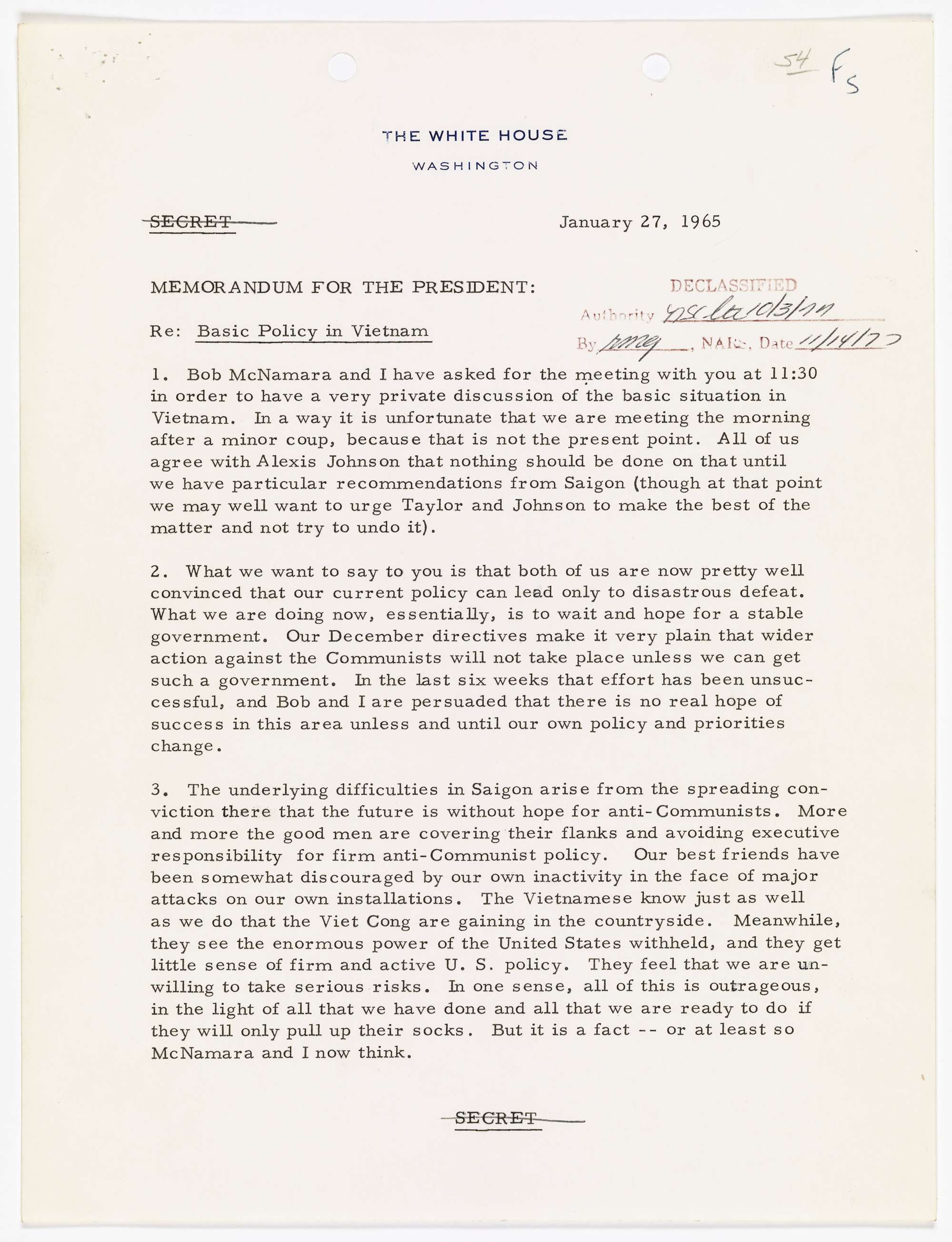
Memo from McGeorge Bundy to President Lyndon B Johnson
Page 2
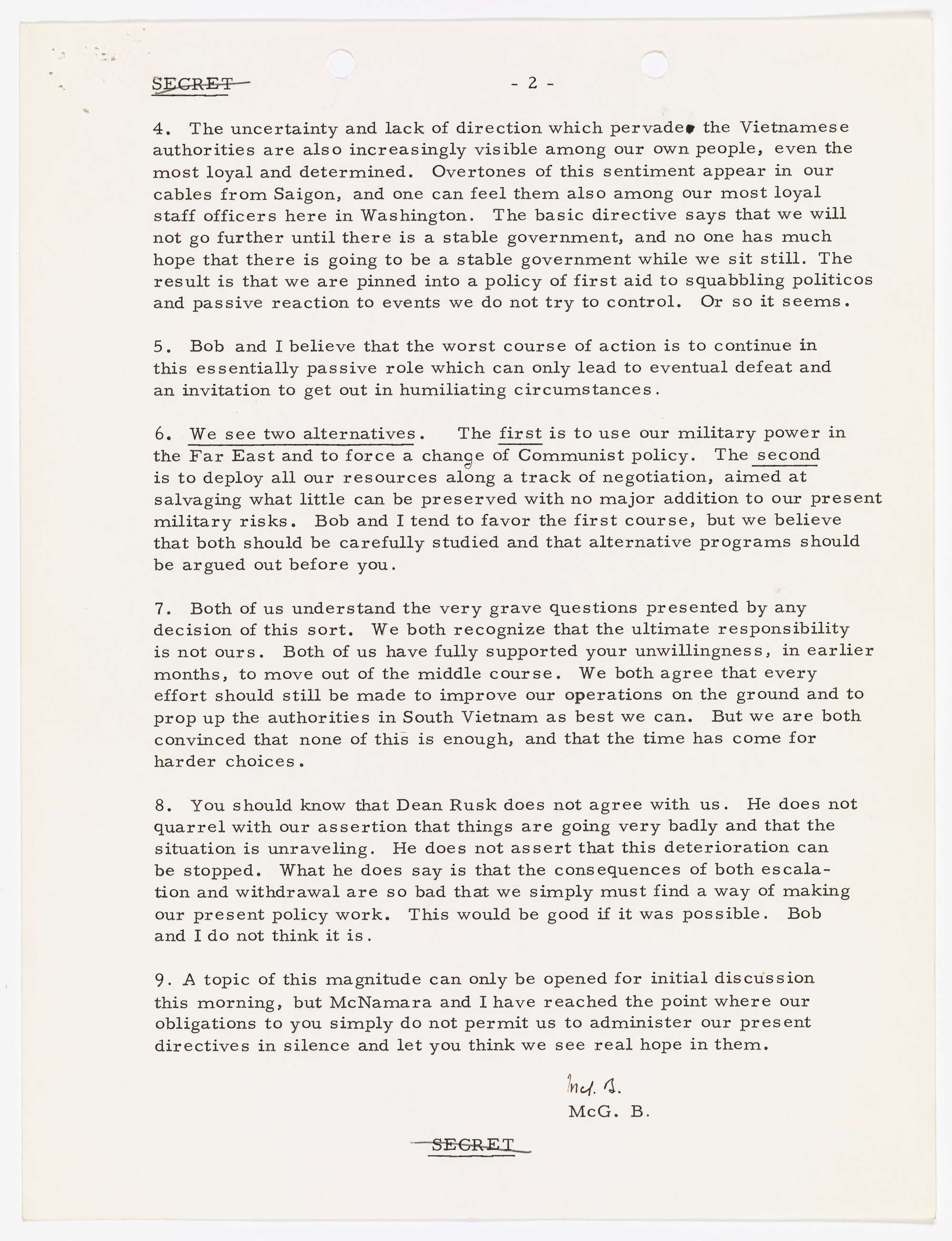
Document
Public Reactions: The March on the Pentagon
10/21/1967
On October 21, 1967, an estimated crowd of 70,000–100,000 demonstrators gathered by the Lincoln Memorial in Washington to protest the Vietnam War and march on the Pentagon in the first major national protest against the war. In addition to the signs, chants, and other hallmarks of an anti-war demonstration, activists distributed daisies, and additionally planned to levitate the Pentagon off its foundation in an act of political theater. By the end of the protest, over 600 protesters had been jailed, and dozens hospitalized.
This primary source comes from the Collection LBJ-WHPO: White House Photo Office Collection.
National Archives Identifier: 192605
Full Citation: Photograph 7052-8; Public Reactions: The March on the Pentagon; 10/21/1967; Johnson White House Photographs, 11/22/1963 - 1/20/1969; Collection LBJ-WHPO: White House Photo Office Collection, ; Lyndon Baines Johnson Library, Austin, TX. [Online Version, https://www.docsteach.org/documents/document/october-march-on-pentagon, April 20, 2024]Public Reactions: The March on the Pentagon
Page 1
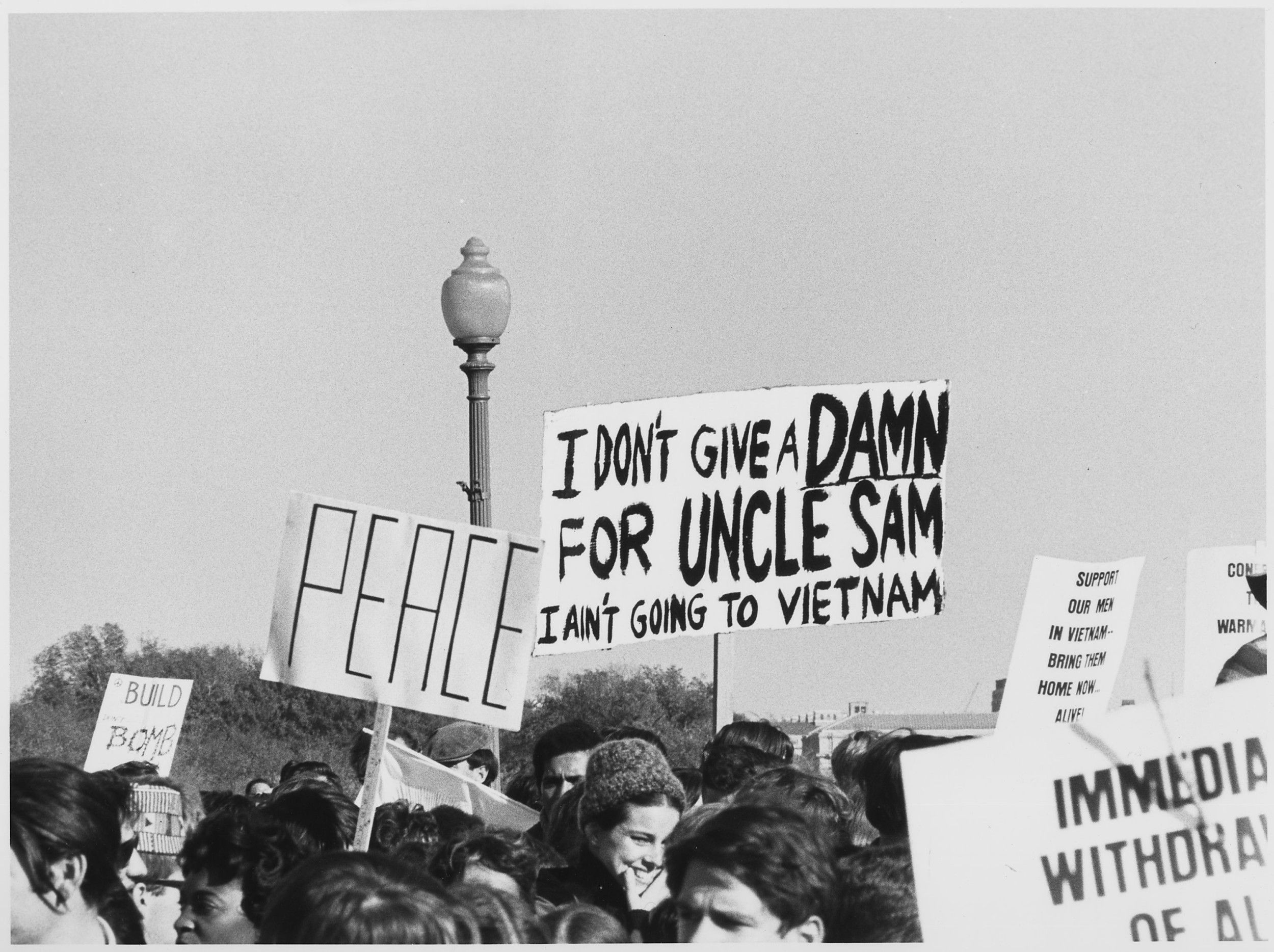
Document
President Lyndon B. Johnson Speech Regarding Bombing Halt and Decision Not to Run for Re-election
3/31/1968
This photograph shows President Lyndon B. Johnson speaking to the nation from the White House Oval Office, surrounded by TV technicians. In his speech, he called for a halt to bombing in Vietnam, greater reliance on the South Vietnamese, and a modest troop increase. In April, North Vietnam agreed to open peace talks.
President Johnson also shocked even his closest advisers when he announced his decision not to run for a second term as President: “I shall not seek, and I will not accept, the nomination of my party for another term as your President.”
President Johnson also shocked even his closest advisers when he announced his decision not to run for a second term as President: “I shall not seek, and I will not accept, the nomination of my party for another term as your President.”
This primary source comes from the Collection LBJ-WHPO: White House Photo Office Collection.
National Archives Identifier: 192619
Full Citation: Photograph C9286-24; President Lyndon B. Johnson Speech Regarding Bombing Halt and Decision Not to Run for Re-election; 3/31/1968; Johnson White House Photographs, 11/22/1963 - 1/20/1969; Collection LBJ-WHPO: White House Photo Office Collection, ; Lyndon Baines Johnson Library, Austin, TX. [Online Version, https://www.docsteach.org/documents/document/oval-office-withdrawal-speech, April 20, 2024]President Lyndon B. Johnson Speech Regarding Bombing Halt and Decision Not to Run for Re-election
Page 1
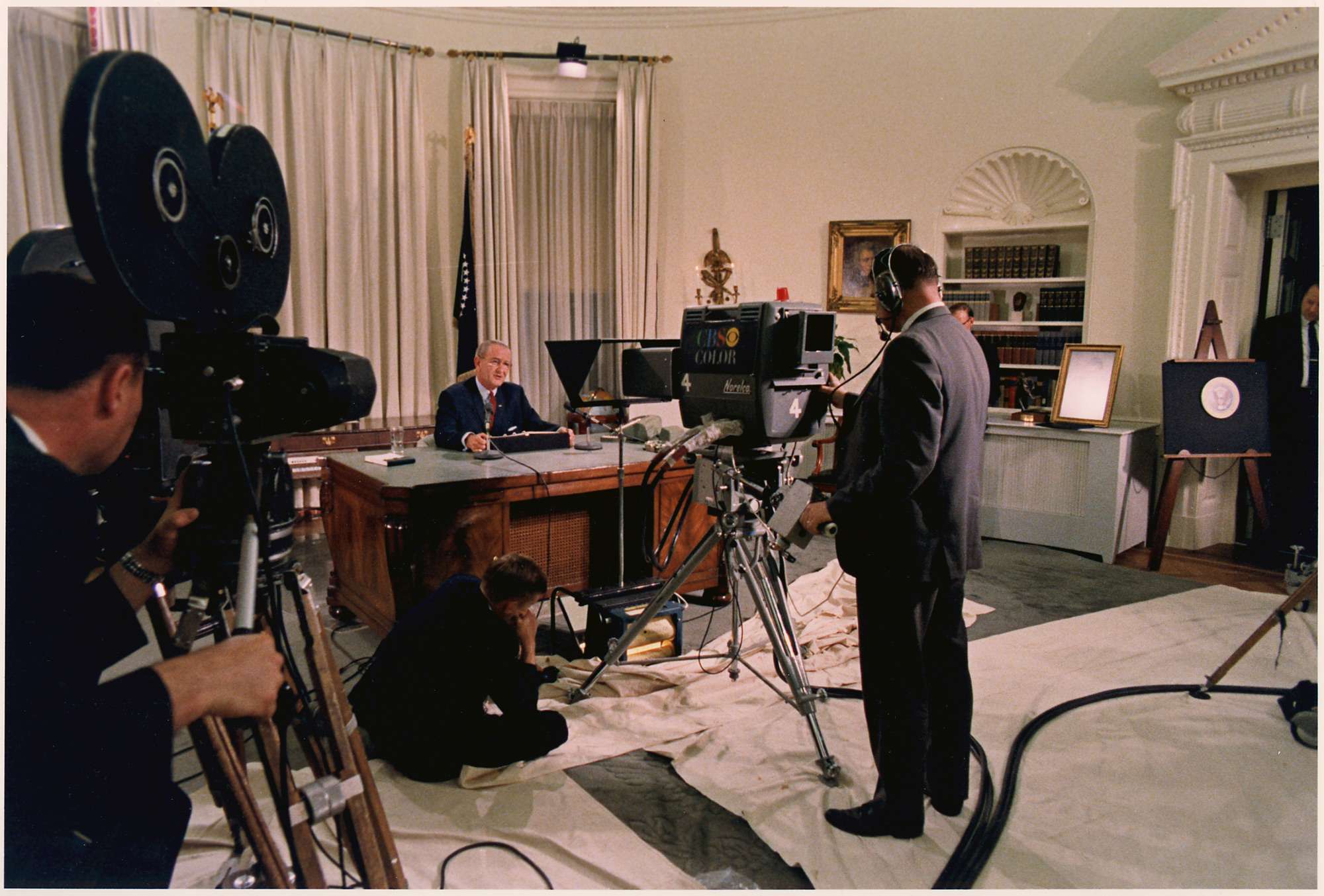
Document
H. R. Haldeman’s Notes
10/22/1968
During a telephone call on the night of October 22, 1968, Presidential candidate Richard M. Nixon told his closest aide (and future chief of staff) H. R. Haldeman to "monkey wrench" President Johnson’s efforts to begin peace talks over the Vietnam War (see the second page of the notes). Nixon was campaigning on ending the Vietnam war and he thought a peace agreement might threaten his election.
Nixon long denied giving such an order, but Haldeman’s notes, which were quietly made public in 2007 and discovered by historian Jack Farrell in 2017, provide evidence of Nixon’s direct involvement.
The first page includes a notation to "keep Anna Chennault working on SVN" (South Vietnam). Nixon had sent Chennault as an emissary to tell President of South Vietnam Thieu, "Hold on, we are gonna win." The implication was clear: Thieu should not sign the peace agreement President Johnson was currently negotiating. When Nixon became President, he would negotiate a peace deal that left Thieu in a more powerful position.
Nixon long denied giving such an order, but Haldeman’s notes, which were quietly made public in 2007 and discovered by historian Jack Farrell in 2017, provide evidence of Nixon’s direct involvement.
The first page includes a notation to "keep Anna Chennault working on SVN" (South Vietnam). Nixon had sent Chennault as an emissary to tell President of South Vietnam Thieu, "Hold on, we are gonna win." The implication was clear: Thieu should not sign the peace agreement President Johnson was currently negotiating. When Nixon became President, he would negotiate a peace deal that left Thieu in a more powerful position.
Transcript
[top left corner] RN [Richard Nixon][crossed out in top right corner] R/W 2
file
10/22
late
Z [Possibly Ron Ziegler who became Nixon’s press secretary] - indicate tomorrow
Preparing & recording 2 radio speeches
Harlow [Bryce Harlow, a Republican strategist and Nixon aide] – Harlow monitoring V.Nam [Vietnam]
Fl – Andrews -if take a poll – inform us immy.
G’ [in red: done] Rhodes [John Rhodes, House Minority Leader] says we’ve dropped on older people – use radio for Soc Sec spot & a nspr [newspaper] ad – nail the lie
R+W – sit down w/ RW + Moore etc. – in terms of their thot [thought] on tempo & content
how do you want him to hit HH [Hubert Humphrey] – how hard?
F? maybe have to bite V.N.
! [illegible] – keep Anna Chennault working on SVN [South Vietnam] – insist [illegible] on the 3 Johnson [President Lyndon B. Johnson] conditions
Z [Ron Ziegler] say for Fri – doing 3 hrs of TV spots
Moore -et al - get a reading on how they thk [think] we’re doing
Harlow – be sure cc [copy] of defense goes to DDE [Dwight D. Eisenhower, former President] & to our defense types.
RW – how do you want him to hit HH [Hubert Humphrey, Democratic Presidential Candidate for 1968] how hard shld [should] he go?
re: V.N. [Vietnam] bomb haltment:
Harlow – have Dirksen [Everett Dirksen, Senator from Illinois] & Tower [John Tower, Senator from Texas] blast this
Dirksen call LBJ [President Lyndon B. Johnson] and brace him w/ [with] this
-any other way to monkey wrench it?
Anything RN can do.
Rose [Rose Mary Woods, Richard Nixon’s personal secretary] – get her frd [?] Louie [illegible] – zing [?] on the SVN [South Vietnamese] – tell him hold firm
Dirksen – or someone
Rebozo [Charles “Bebe” Rebozo, Florida banker and businessman who was a friend and confidant of Richard Nixon] – have Smathers [George Smathers, Senator from Florida] threaten J [President Lyndon B. Johnson]
N [Richard Nixon] has learned staffers are dealing w/ H [Hubert Humphrey, Democratic Presidential Candidate for 1968] & N [Richard Nixon] is going to blast him –
the bets are off & N [Richard Nixon] very disapptd [disappointed]
hard evidence W/house [White House] is giving H [Hubert Humphrey, Democratic Presidential Candidate for 1968] stuff he’s not giving N [Richard Nixon]
will blast in major speech on V.N. [Vietnam] on Thurs –
10/22
file
[crossed out]
213-
277-2000
1739
-ABC confirming 2 hrs 8:30-10:30 Mon nite
says he’ll do telethon – now AT&T problem
-G just 1 & 5 min. very good
C – booking [illegible] 11:30 Fri AM
tape Congress radio spot –
NO? – Las Vegas prop stop – rec H. Baker [Howard Baker, Senator from Tennessee]
F – press conf – 2 today – re polls
extra – hard drive
Ray A [Possibly Ray Arbuthnot?] – workers told RN [Richard Nixon] – not working as hard as ’60 [1960 Presidential Campaign]
2
-ask him about Va. [Virginia]
– talk to Jack Kilpatrick [James J. Kilpatrick, newspaper columnist] (ch B)
column for Star – [illegible] paper
fnd of Buckley’s [William F. Buckley, author and commentator] –
give him honest shake on polls – outlook
-get Sun Times [Chicago Sun-Times newspaper] poll every day
B - [illegible] – can go three releases last couple days
pick out lines to be used in stump speech
Keo themes
– one theme for releases –
– harlow [Bryce Harlow] uncertain trumpet
miscalculation – can lead to wars
– most confused candidate in history
– go back to forgotten American theme
– admitted he can’t get the popular vote
can’t unite his party –
[top left] Add Harlow
– Harlow fly to V.N. [Vietname] – see Goodpaster [Andrew Goodpaster, U.S. Army General]
RN [Richard Nixon] sure military not for it.
– this might make SVN [South Vietnamese] govt. fall
– tomorrow RN [Richard Nixon] blandly say US shld [should] pause [underlined] under conditions J [President Lyndon B. Johnson] laid down in N Orleans [New Orleans]
ie go further than present position
if conditions are not met that J [President Lyndon B. Johnson] laid down then we would approve bomb pause
but H [Hubert Humphrey, Democratic Presidential Candidate for 1968] is wrong in saying pause [underlined] period
to give away our trump card w/o getting this much would be bad
they’re selling out SVN [South Vietnam]– leave new admin to hdl [handle]
make a communist Asia –
wld [would] have to go into Thailand.
Bebe – N [Richard Nixon] mad as hell –
W House staffers (many) [written above: Clifford [Clark Clifford, Presidential advisor], Califano [Joseph A. Califano, Special Assistant to President Lyndon B. Johnson] & L. Thompson] are now talking to H [Hubert Humphrey, Democratic Presidential Candidate for 1968] giving info they’re not giving N [Richard Nixon]
thot [thought] that at Al Smith dinner they had an understanding
now is going to blast LBJ [President Lyndon B. Johnson] – Thurs.
(Bebe – our private polls show we lead in every one of critical states.)
talking to H [Hubert Humphrey, Democratic Presidential Candidate for 1968] & working w/ Ball [George Ball, Johnson presidential advisor who opposed escalation of the Vietnam war]
Har – Harlow [Bryce Harlow] – try Burke, Radford, Guenther
find out what’s going on
Les Arends [House Representative from Illinois] – Mel Laird [House Representative from Wisconsin and later Nixon’s Secretary of Defense]
have Dirksen call J [President Lyndon B. Johnson]
Har [Bryce Harlow]– Scranton [William Scranton, former Governor of Pennsylvania] call Vance [Cyrus Vance, former Deputy Secretary of Defense]
heard rumor – N [Richard Nixon] very distressed what’s going on
Har [Harlow] – tell Dirksen if don’t get 3 conditions N [Richard Nixon] will blast bomb halt
Agnew [Spiro T. Agnew, Nixon’s running mate and later Vice President] – go see Helms [Richard Helms, Director of the Central Intelligence Agency] –
tell him we want the truth – or he hasn’t got the job.
10/22
[crossed out] E/Chot.- Kl [Possibly Herb Klein, national communications manager for Nixon’s 1968 Presidential campaign] – Agnew hit on [underlined] popular vote –
[underlined] report mid day – Chot E etc have done
also surrogates –
who handling etc.
– gamesmanship on CBS – feel of our figures.
– Ck Minn. today – late polls?
FL– any results on phone operation
M-G – get G – up TV budget by another million because Dems tendency to blitz & they now have the $
G – be sure our spots are now effective
Moore strongly against W. Wallace
– have screening?
gut issues – hitting strong enuf [enough]
have to step up –
? raised $300M for one 5-min Dem spot
Chot-Kl [?] – in South – danger that H’s [Hubert Humphrey, Democratic Presidential Candidate for 1968] going to be Pres.
— [illegible] attack on popular vote
E – popular vote attack on HH [Hubert Humphrey, Democratic Presidential Candidate for 1968]
F – step up pollsmanship
1st step – local state chmn [chairman]– put out their [illegible] run optimism deal in terms of press
esp. Charlie [possibly Charles Colson, counsel to candidate Nixon’s Key Issues Committee, and later Special Counsel to President Nixon] – talking to press
– not much more for RN [Richard Nixon] to do
will hit hard – hope for the best
M – keep grinding – don’t let them let up.
put out some of [illegible] polls – as local polls
but as ORC [Opinion Research Corporation] poll – Missouri –
Klein [Herb Klein] – what papers talked to – [illegible] on book – etc.
report
– esp. concerned re G. & TV – feels not tough enuf. [enough]
P. Hitt [Patricia Reilly Hitt, longtime Nixon supporter and later Assistant Secretary of Health, Education and Welfare in the Nixon administration] – get reading on bumper strip day
Kl [Herb Klein] run something on what was done
– ride hard on Rhyne [possibly Charles Rhyne, a Nixon classmate at Duke University Law School] & P. Hitt –
get on people to get to work
Pat [possibly Patricia Hitt] skip mtgs [meetings] & stuff – just ride on our troops.
3
T
VC [?]– want to know today what ORC time lag is
– how far behind is report from field work
is this wave the last –
or do we get something next Thurs.
& need to know when the thing is through
Check Tex. & Minn.
This primary source comes from the Collection RN-RET: Richard M. Nixon's Returned Materials Collection.
National Archives Identifier: 26126861
Full Citation: H. R. Haldeman’s Notes; 10/22/1968; WHSF: Returned, 33-8; Returned White House Special Files, 1/1969 - 8/1974; Collection RN-RET: Richard M. Nixon's Returned Materials Collection, ; Richard Nixon Library, Yorba Linda, CA. [Online Version, https://www.docsteach.org/documents/document/haldemans-notes, April 20, 2024]H. R. Haldeman’s Notes
Page 1

H. R. Haldeman’s Notes
Page 2
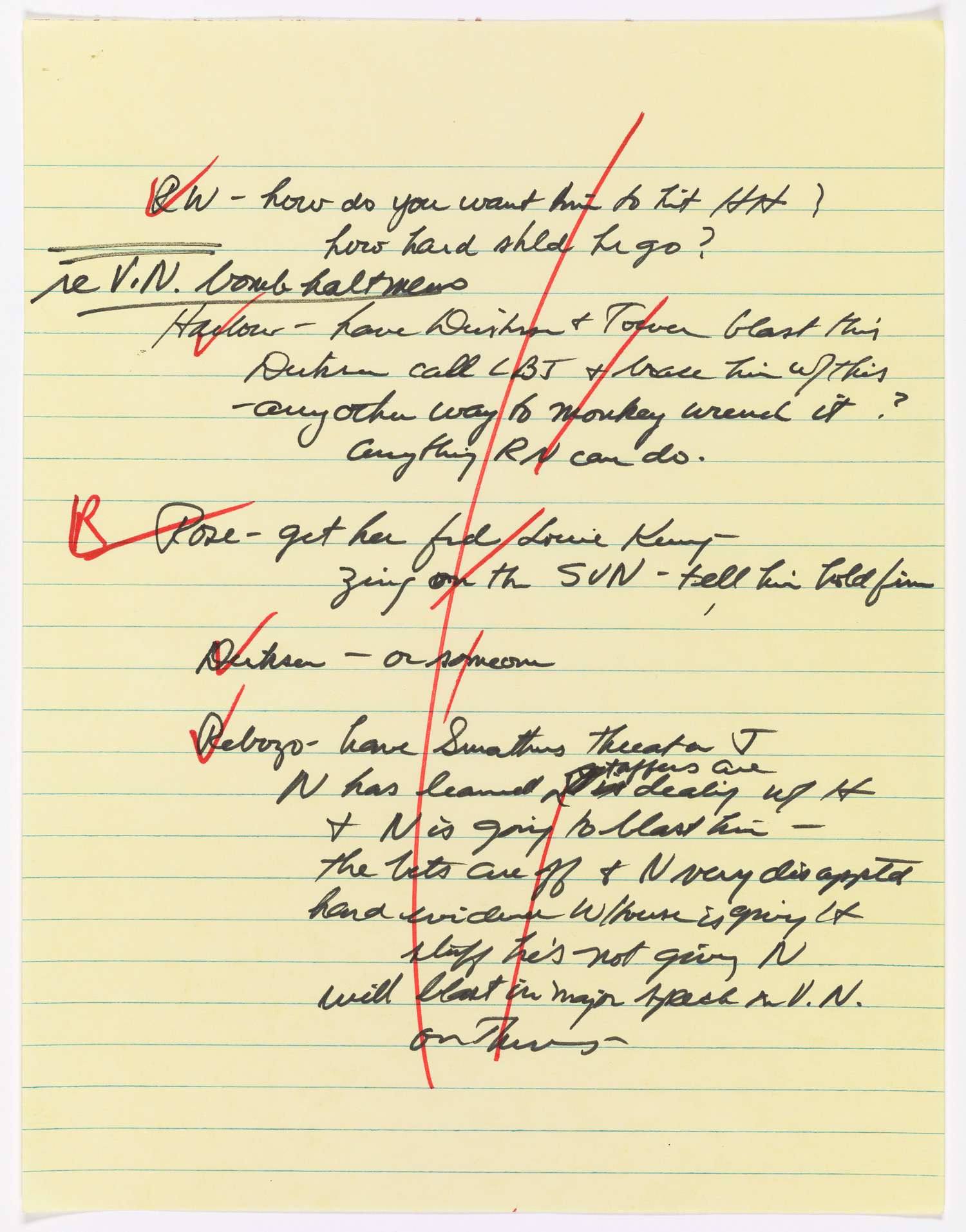
H. R. Haldeman’s Notes
Page 3
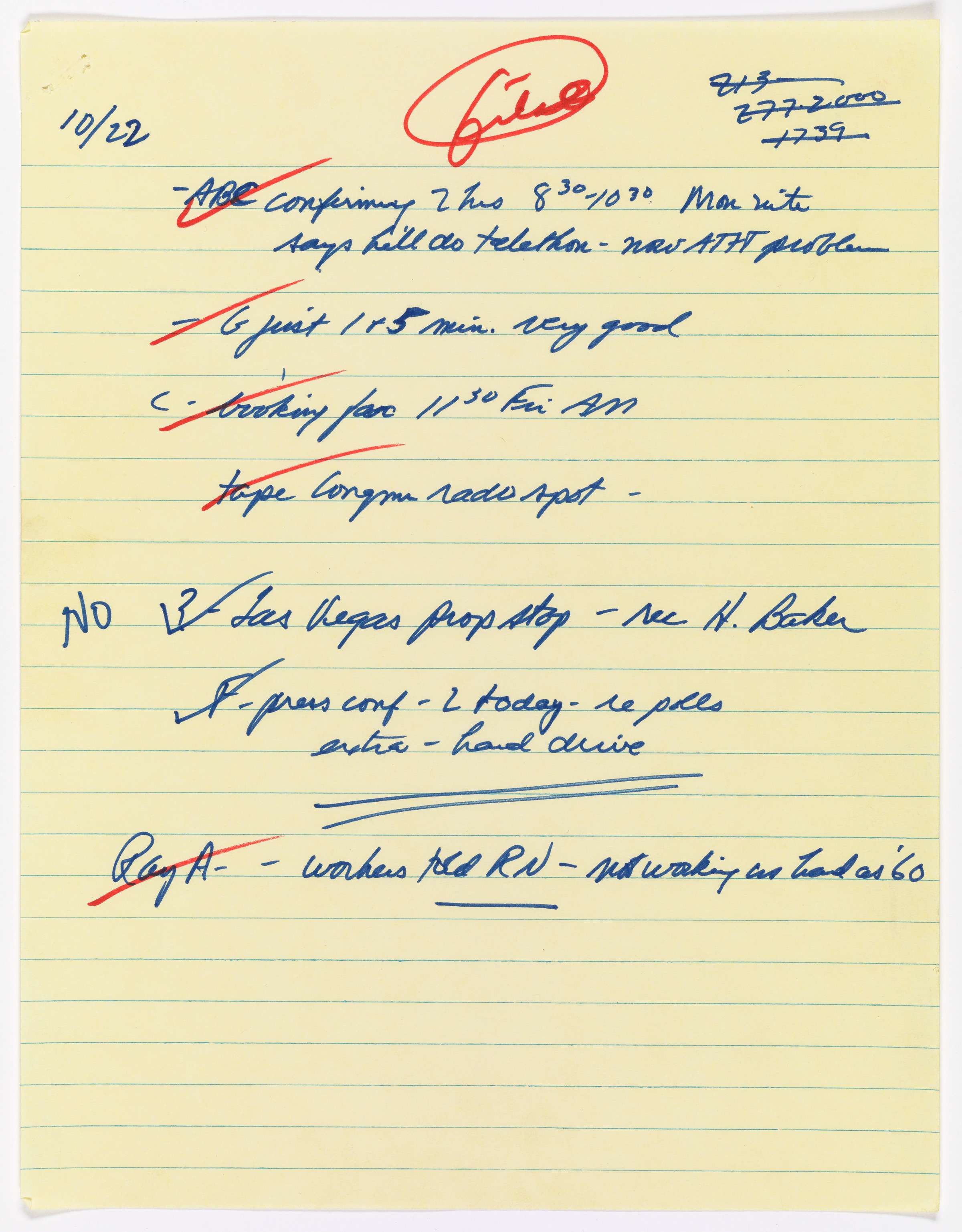
H. R. Haldeman’s Notes
Page 4
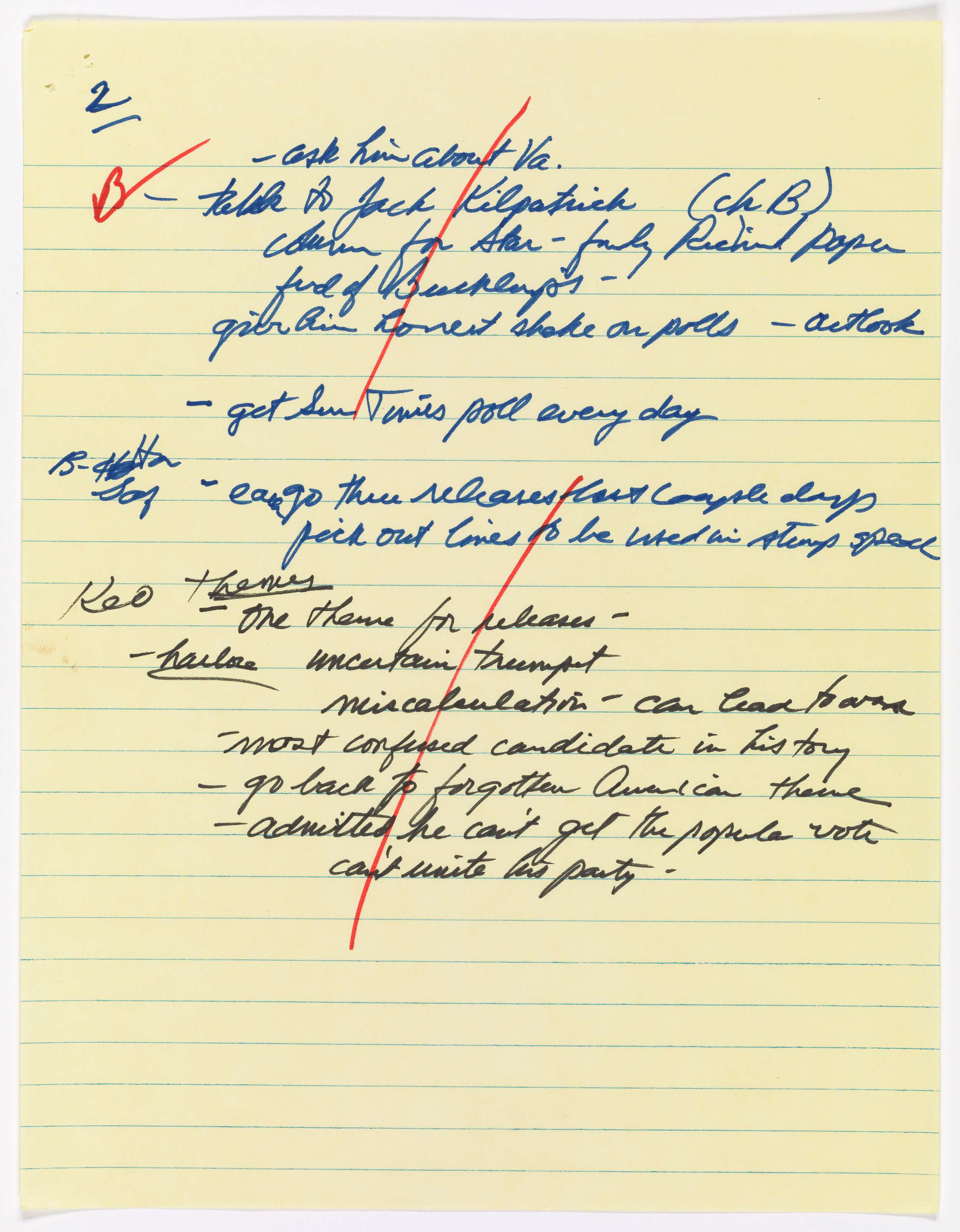
H. R. Haldeman’s Notes
Page 5

H. R. Haldeman’s Notes
Page 6
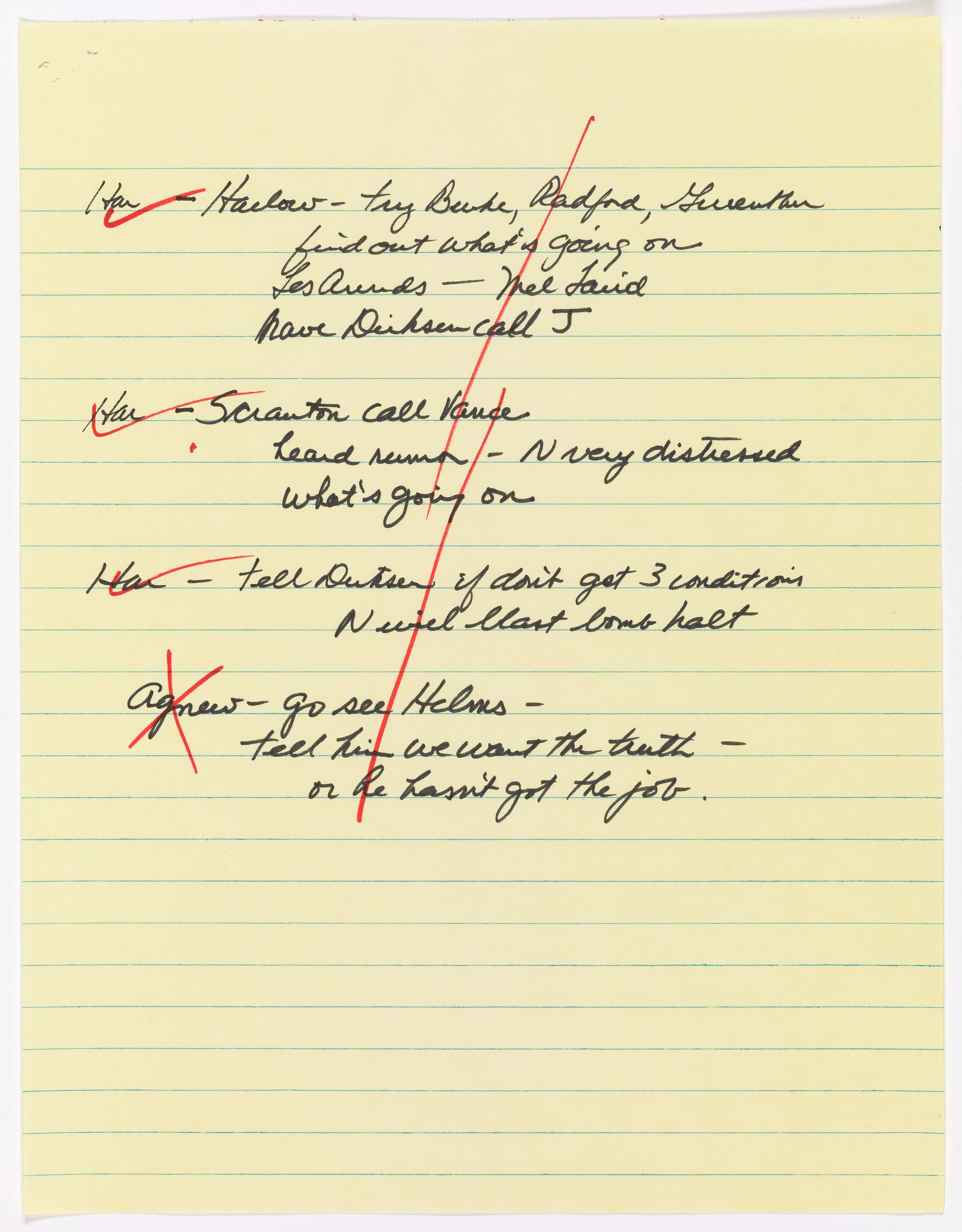
H. R. Haldeman’s Notes
Page 7
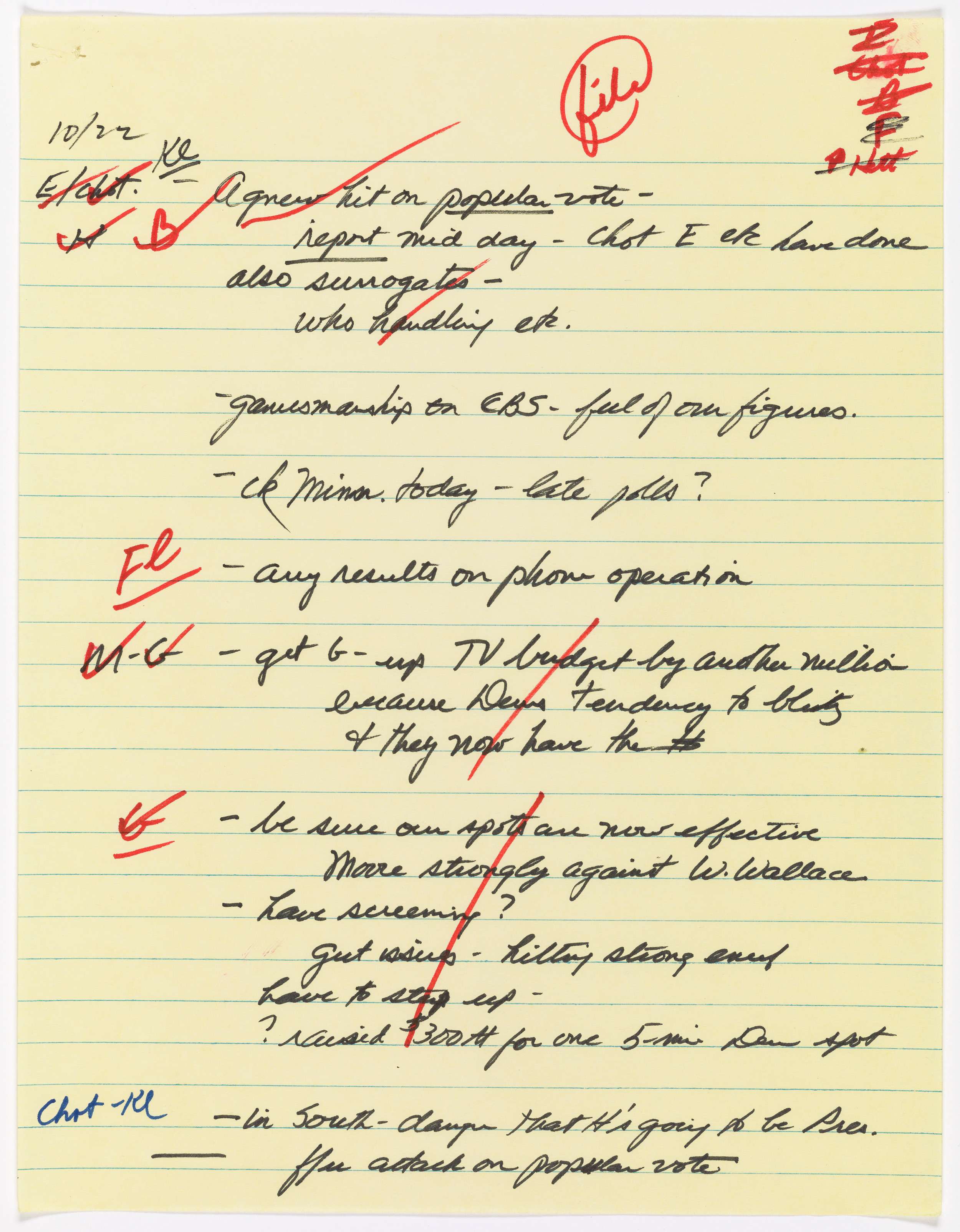
H. R. Haldeman’s Notes
Page 8

H. R. Haldeman’s Notes
Page 9

Document
Campus Scene, Kent State University (OH)
5/4/1970
In the midst of Vietnam War, President Nixon had decided to initiate the Cambodian campaign. This apparent expansion of the Vietnam War detonated an explosion of antiwar activity that escalated to a national crisis when four students were shot at a protest at Kent State University in Ohio.
Students had been protesting for days when the town mayor declared a state of emergency and called in the National Guard to help reestablish order. There were over 1,300 armed troops, armored personnel carriers, mortar launchers, and helicopters on the Kent State University campus on May 4, 1970.
Ohio National Guard troops opened fire on unarmed students. In a period of 13 seconds, 67 shots were fired, wounding nine—one paralyzed for life—and killing four students. Two of the slain victims were not protesters; they were walking to class. One was a member of the ROTC (Reserve Officers Training Corps) who was planning to go into the military.
News of the shootings rocked the nation. Many were outraged, but according to a Gallup Poll, 58 percent of Americans blamed the students for the violence at Kent State. Dean Kahler, who was shot and paralyzed during the attack, opened a letter when he came out of an induced coma. It began, “Dear communist hippie radical, I hope by the time you read this, you are dead.”
In response to the shootings President Nixon said, “When dissent turns to violence, it invites tragedy.” Others were horrified and erupted in protest. An estimated four million striking students shut down 800 campuses nationwide.
President Nixon created the President’s Commission on Campus Unrest to investigate protest at schools across the country. It concluded that “the indiscriminate firing of rifles into a crowd of students and the deaths that followed were unnecessary, unwarranted and inexcusable.” A federal grand jury indicted eight guardsmen, but found they were not subject to criminal prosecution because they acted in self defense.
Students had been protesting for days when the town mayor declared a state of emergency and called in the National Guard to help reestablish order. There were over 1,300 armed troops, armored personnel carriers, mortar launchers, and helicopters on the Kent State University campus on May 4, 1970.
Ohio National Guard troops opened fire on unarmed students. In a period of 13 seconds, 67 shots were fired, wounding nine—one paralyzed for life—and killing four students. Two of the slain victims were not protesters; they were walking to class. One was a member of the ROTC (Reserve Officers Training Corps) who was planning to go into the military.
News of the shootings rocked the nation. Many were outraged, but according to a Gallup Poll, 58 percent of Americans blamed the students for the violence at Kent State. Dean Kahler, who was shot and paralyzed during the attack, opened a letter when he came out of an induced coma. It began, “Dear communist hippie radical, I hope by the time you read this, you are dead.”
In response to the shootings President Nixon said, “When dissent turns to violence, it invites tragedy.” Others were horrified and erupted in protest. An estimated four million striking students shut down 800 campuses nationwide.
President Nixon created the President’s Commission on Campus Unrest to investigate protest at schools across the country. It concluded that “the indiscriminate firing of rifles into a crowd of students and the deaths that followed were unnecessary, unwarranted and inexcusable.” A federal grand jury indicted eight guardsmen, but found they were not subject to criminal prosecution because they acted in self defense.
This primary source comes from the Records of U.S. Attorneys.
National Archives Identifier: 18542766
Full Citation: Campus Scene, Kent State University (OH); 5/4/1970; The United States of America v. Lawrence Shafer, James Pierce, William Perkins, James McGee, Barry Morris, Ralph Zoller, Matthew McManus, Leon Smith (Fire Bombing and Shooting at Kent State); Case Files, 1918 - 1974; Records of U.S. Attorneys, ; National Archives at Chicago, Chicago, IL. [Online Version, https://www.docsteach.org/documents/document/campus-scene-kent-state, April 20, 2024]Campus Scene, Kent State University (OH)
Page 1
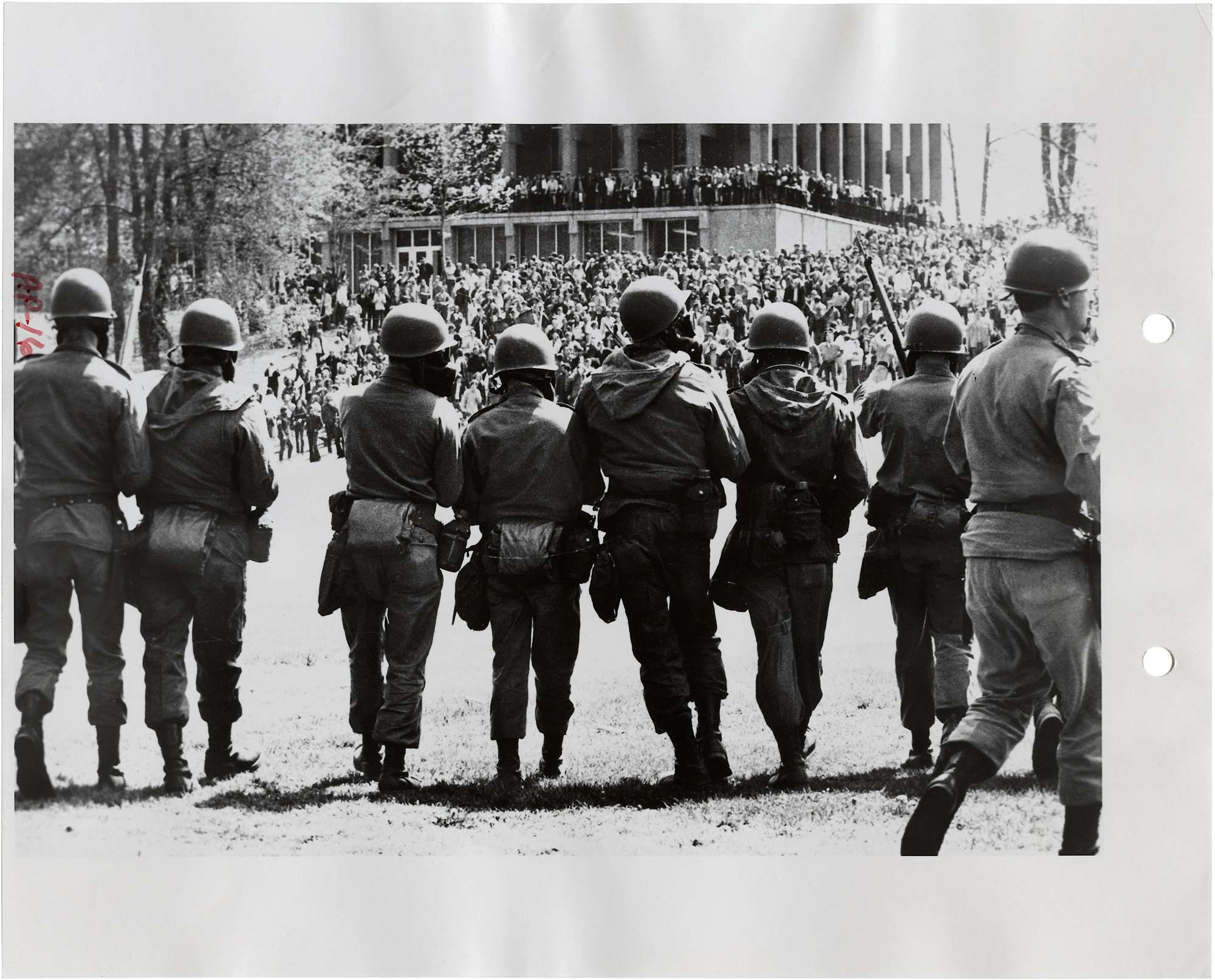
Document
Text of Letter from President Nixon to President Thieu
12/17/1972
National Security Advisor Henry Kissinger had began backchannel negotiations with North Vietnam in February 1970 to try to end the Vietnam War. Hoping to gain an edge in these deliberations, North Vietnam attacked South Vietnam in March 1972. President Nixon was enraged by this "Spring Offensive" and retaliated by bombing.
In October 1972, a defeated North Vietnam made concessions and Kissinger announced "peace is at hand." But South Vietnamese President Thieu balked at the agreement and demanded changes. When Kissinger attempted to renegotiate, the talks collapsed.
Nixon blamed North Vietnam and ordered a massive "Christmas Bombing" to bring both sides back to the table. In this letter to Thieu, President Richard Nixon describes two motives for his December "Christmas Bombing," which would take place the next day, December 18, 1972. He wants to quickly end the conflict, and to demonstrate how he would respond if the peace agreement were violated. Nixon was trying to convince a reluctant Thieu to sign the agreement by showing his commitment to South Vietnam.
In October 1972, a defeated North Vietnam made concessions and Kissinger announced "peace is at hand." But South Vietnamese President Thieu balked at the agreement and demanded changes. When Kissinger attempted to renegotiate, the talks collapsed.
Nixon blamed North Vietnam and ordered a massive "Christmas Bombing" to bring both sides back to the table. In this letter to Thieu, President Richard Nixon describes two motives for his December "Christmas Bombing," which would take place the next day, December 18, 1972. He wants to quickly end the conflict, and to demonstrate how he would respond if the peace agreement were violated. Nixon was trying to convince a reluctant Thieu to sign the agreement by showing his commitment to South Vietnam.
This primary source comes from the Collection RN-SMOF: White House Staff Member and Office Files (Nixon Administration).
Full Citation: Text of Letter from President Nixon to President Thieu; 12/17/1972; President's Personal Files, 1/20/1969 - 8/9/1974; Collection RN-SMOF: White House Staff Member and Office Files (Nixon Administration), ; Richard Nixon Library, Yorba Linda, CA. [Online Version, https://www.docsteach.org/documents/document/letter-president-nixon-president-thieu, April 20, 2024]Text of Letter from President Nixon to President Thieu
Page 1
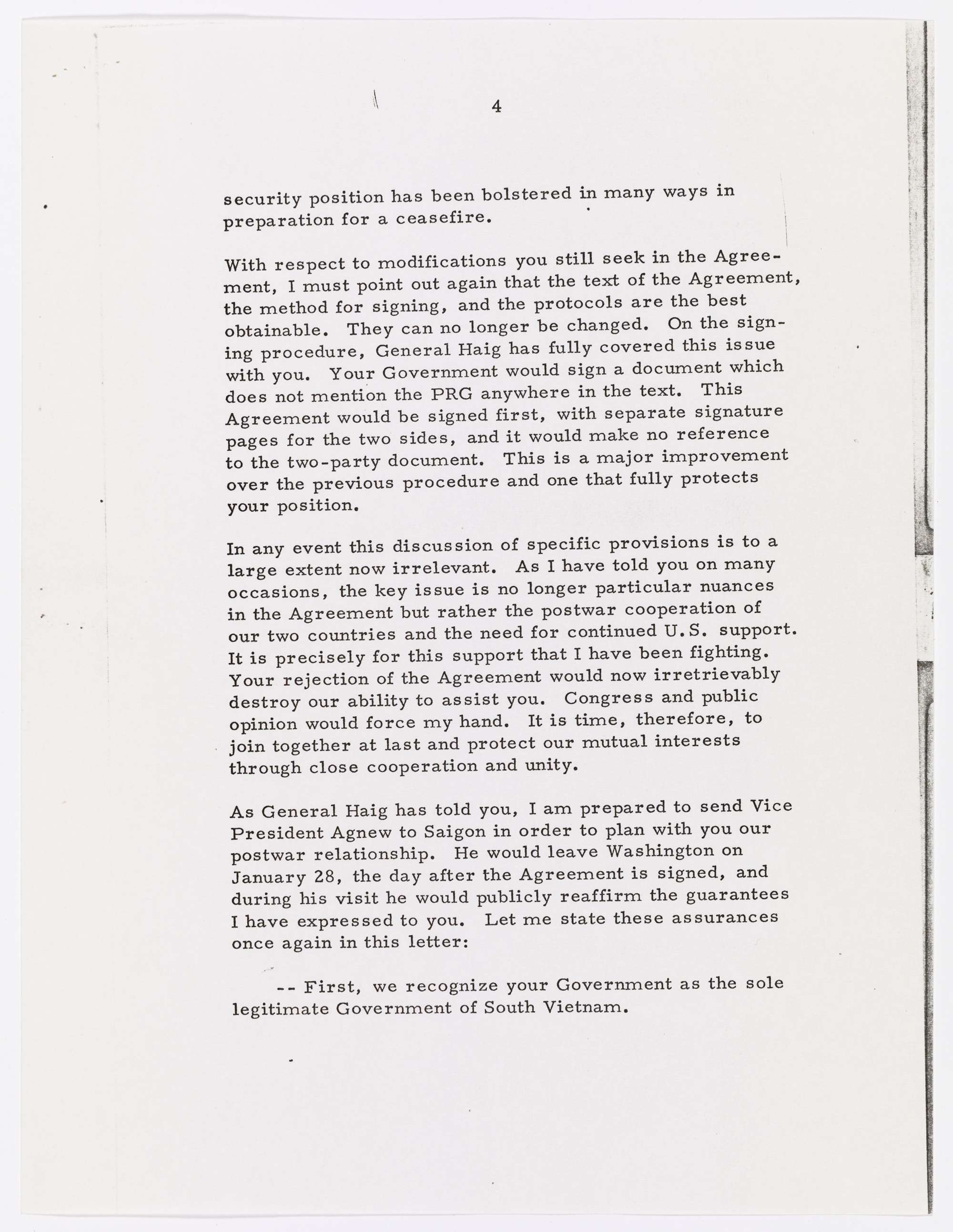
Text of Letter from President Nixon to President Thieu
Page 2

Document
Multilateral Agreement between the United States, Democratic Republic of Vietnam, Republic of Vietnam, and Provisional Revolutionary Government of Vietnam (English)
1/27/1973
This is the "Agreement Ending the War and Restoring Peace in Viet-nam." The first pages and signatures are shown here.
On January 27, 1973, the Paris Peace Accords officially ended the war in Vietnam. South Vietnamese President Thieu reluctantly signed after President Nixon secretly promised "swift and severe retaliatory action" against North Vietnam if they violated the agreement.
Nixon and National Security Advisor Henry Kissinger declared they had achieved “peace with honor” and hoped it would last long enough to give Saigon a fighting chance. In fact the war was far from over. Fighting between Saigon and Hanoi continued and even increased in parts of South Vietnam. North Vietnam began preparations to overtake the South. President Nixon, embroiled in the Watergate scandal, did not have the political capital to provide the backup he had repeatedly promised his ally, President Thieu.
On January 27, 1973, the Paris Peace Accords officially ended the war in Vietnam. South Vietnamese President Thieu reluctantly signed after President Nixon secretly promised "swift and severe retaliatory action" against North Vietnam if they violated the agreement.
Nixon and National Security Advisor Henry Kissinger declared they had achieved “peace with honor” and hoped it would last long enough to give Saigon a fighting chance. In fact the war was far from over. Fighting between Saigon and Hanoi continued and even increased in parts of South Vietnam. North Vietnam began preparations to overtake the South. President Nixon, embroiled in the Watergate scandal, did not have the political capital to provide the backup he had repeatedly promised his ally, President Thieu.
This primary source comes from the General Records of the United States Government.
National Archives Identifier: 28264014
Full Citation: Multilateral Agreement between the United States, Democratic Republic of Vietnam, Republic of Vietnam, and Provisional Revolutionary Government of Vietnam (English); 1/27/1973; TIAS 7542; Multilateral and Bilateral: Ending the War and Restoring Peace in Viet-Nam, January 27, 1973 (Folder 3 of 4, Bilateral - English Text); "Paris Peace Accord"; Treaties and Other International Acts, 1942 - 1995; General Records of the United States Government, ; National Archives Building, Washington, DC. [Online Version, https://www.docsteach.org/documents/document/paris-peace-accords, April 20, 2024]Multilateral Agreement between the United States, Democratic Republic of Vietnam, Republic of Vietnam, and Provisional Revolutionary Government of Vietnam (English)
Page 1
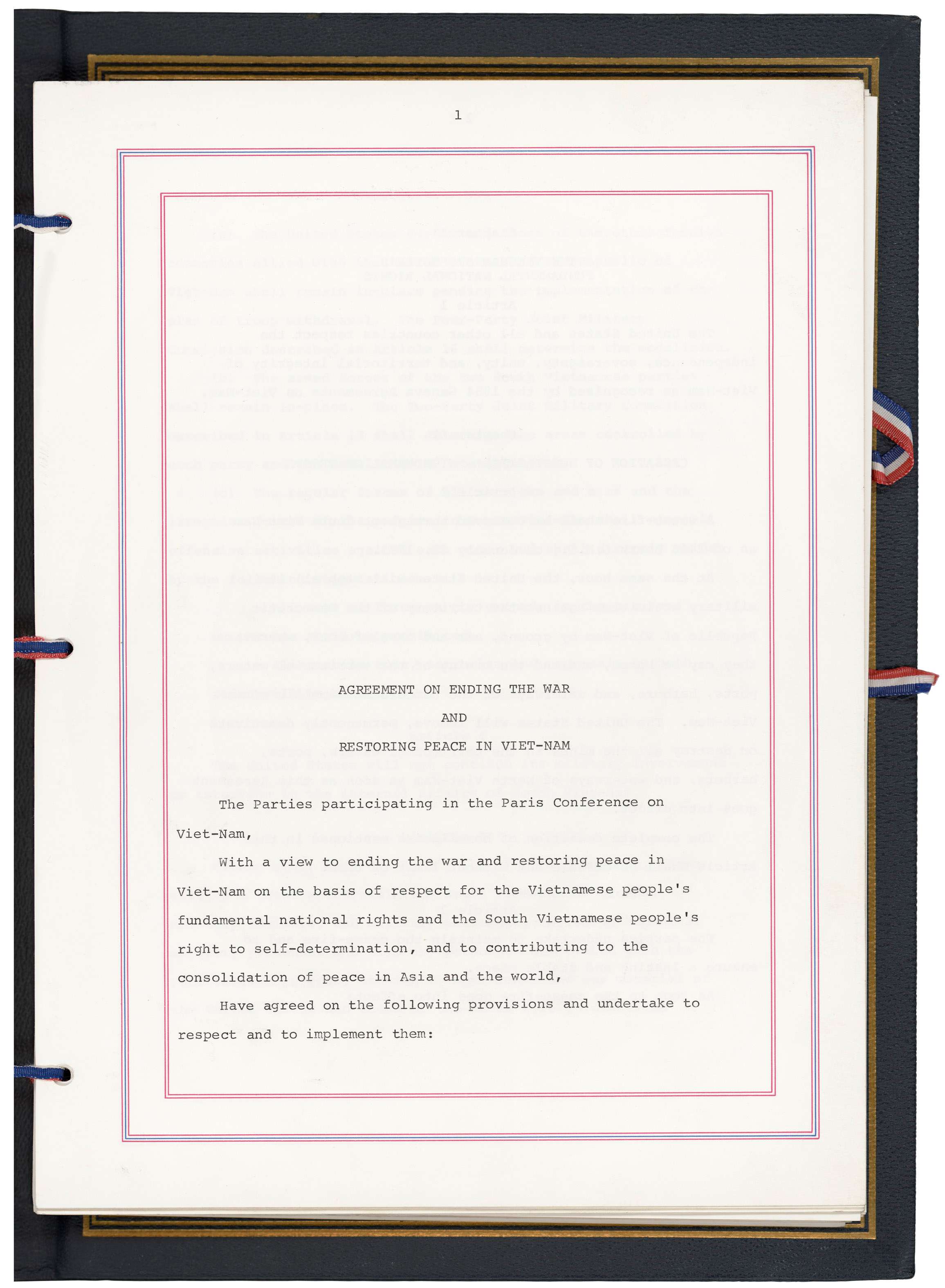
Multilateral Agreement between the United States, Democratic Republic of Vietnam, Republic of Vietnam, and Provisional Revolutionary Government of Vietnam (English)
Page 2
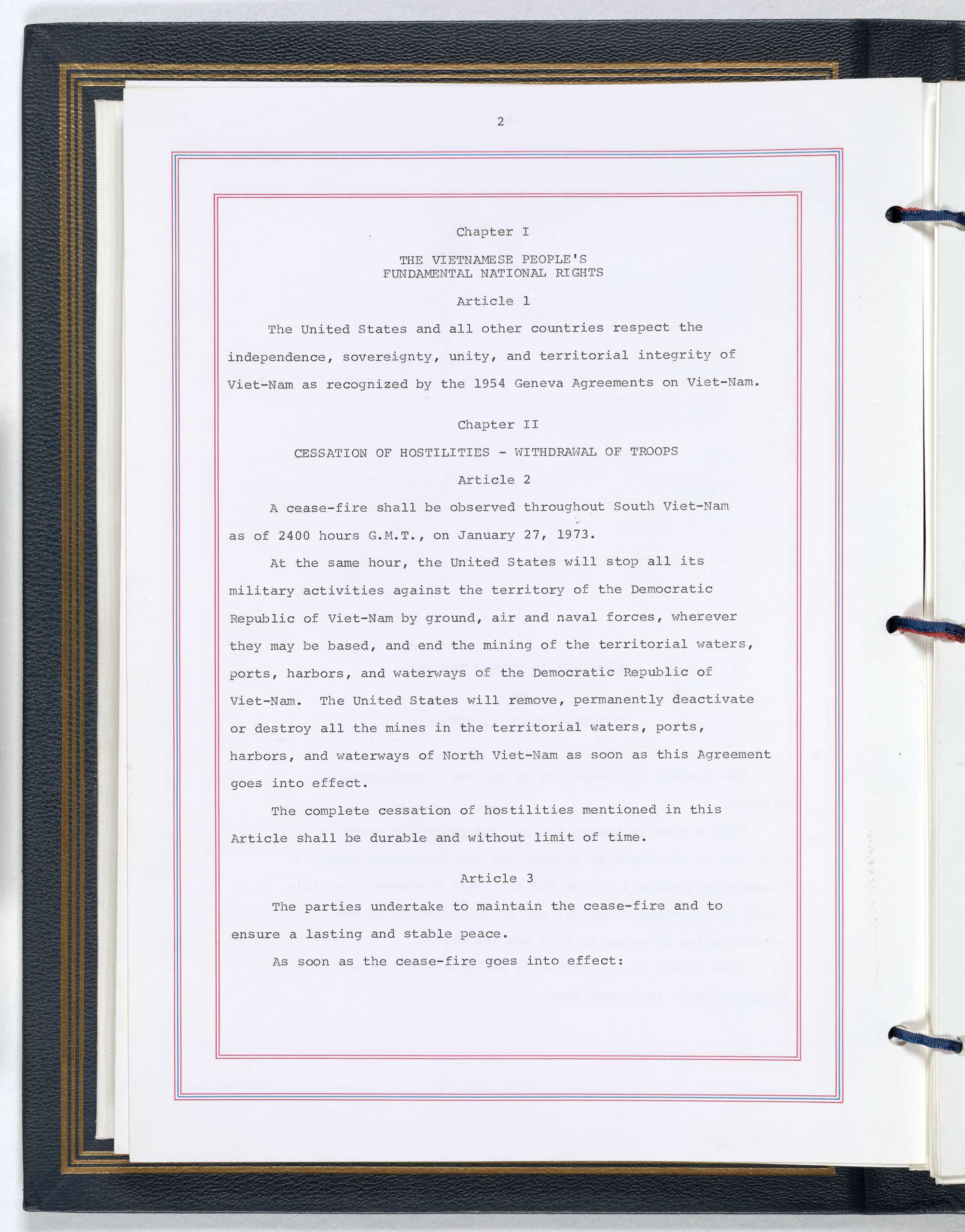
Multilateral Agreement between the United States, Democratic Republic of Vietnam, Republic of Vietnam, and Provisional Revolutionary Government of Vietnam (English)
Page 3
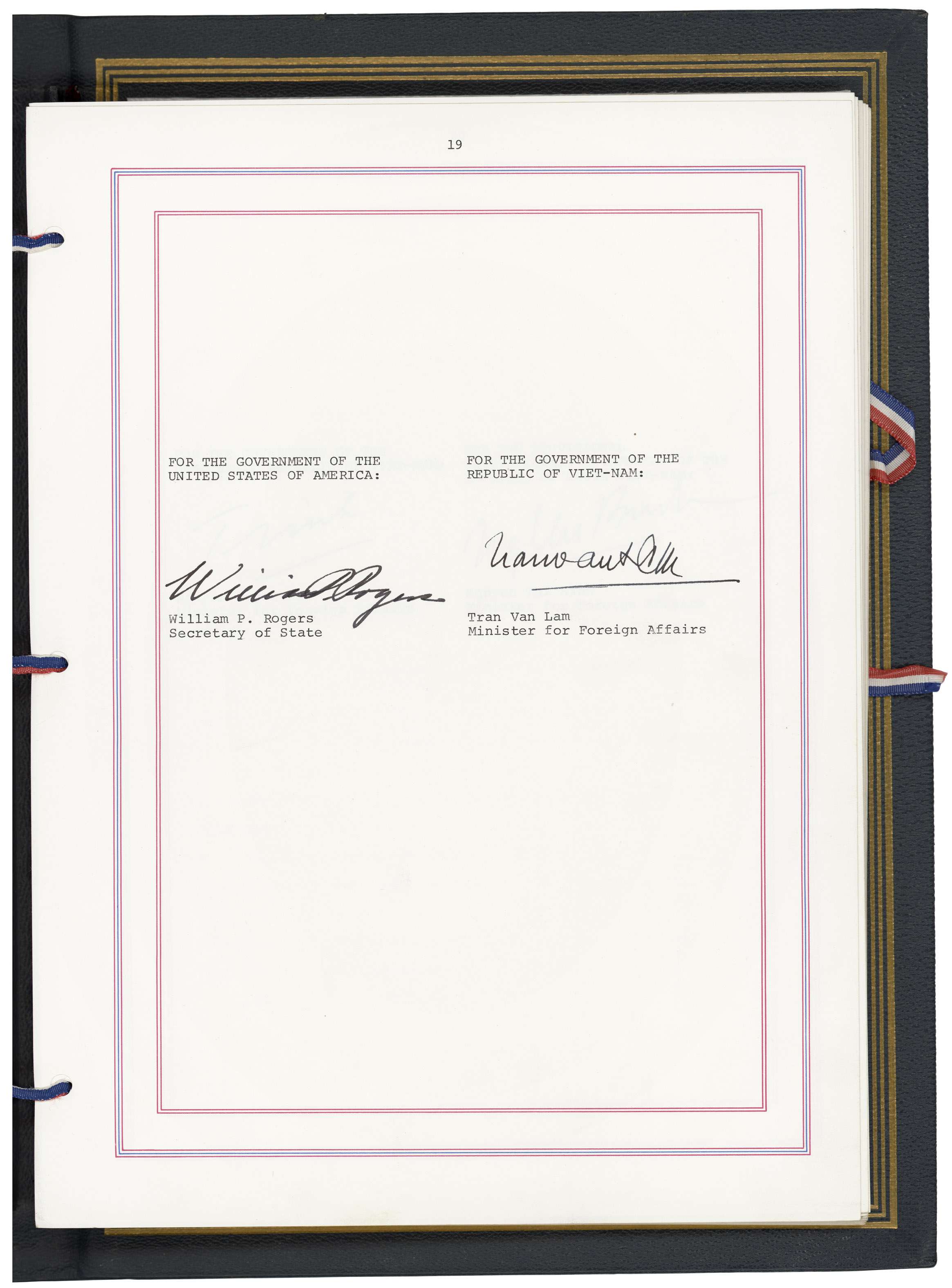
Multilateral Agreement between the United States, Democratic Republic of Vietnam, Republic of Vietnam, and Provisional Revolutionary Government of Vietnam (English)
Page 4
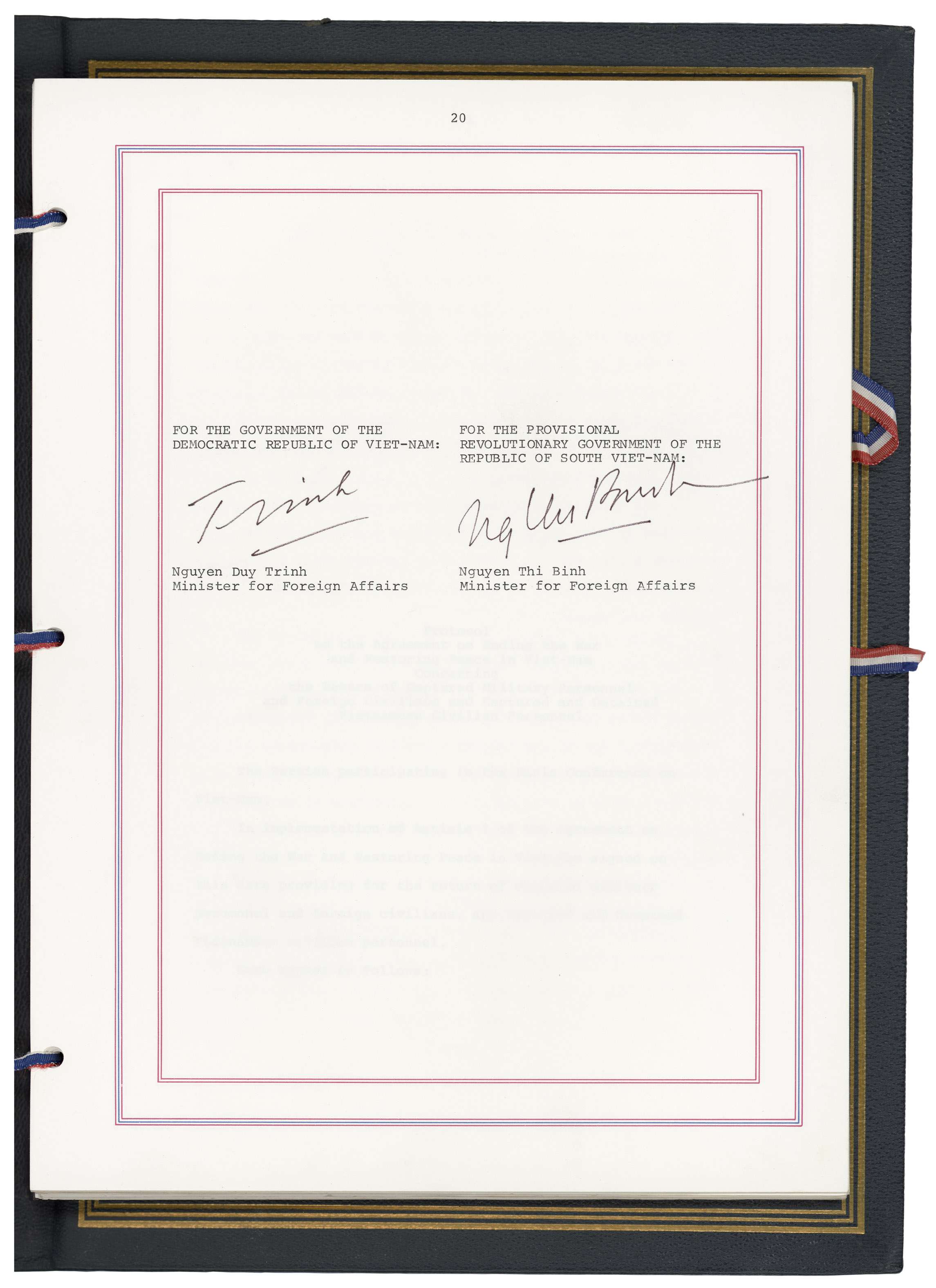
Document
Telegram from Ambassador Graham Martin Concerning the Evacuation of Saigon, South Vietnam
4/29/1975
Ambassador Graham Martin sent this telegram to National Security Adviser Brent Scowcroft, at the White House, during the evacuation of Saigon during the Vietnam War. He states that he is "well aware of the danger here tomorrow and I want to get out tonight." He asks that the President send an order to finish the job quickly, evacuating the rest of the Americans and their children.
The American Ambassador to Vietnam resisted limiting the evacuation to Americans. In this cable he asks with evident desperation, “Perhaps you can tell me how to make some of these Americans abandon their half Vietnamese children?” Before sunrise on April 30, the Ambassador was forced to leave while a few hundred Vietnamese still awaited rescue.
The American Ambassador to Vietnam resisted limiting the evacuation to Americans. In this cable he asks with evident desperation, “Perhaps you can tell me how to make some of these Americans abandon their half Vietnamese children?” Before sunrise on April 30, the Ambassador was forced to leave while a few hundred Vietnamese still awaited rescue.
This primary source comes from the Collection GRF-0330: Backchannel Messages (Ford Administration).
National Archives Identifier: 7367441
Full Citation: Telegram from Ambassador Graham Martin Concerning the Evacuation of Saigon, South Vietnam; 4/29/1975; Martin Channel, April 1975 - Incoming (3); Backchannel Cable Files, 1974 - 1977; Collection GRF-0330: Backchannel Messages (Ford Administration), ; Gerald R. Ford Library, Ann Arbor, MI. [Online Version, https://www.docsteach.org/documents/document/telegram-martin-evacuation, April 20, 2024]Telegram from Ambassador Graham Martin Concerning the Evacuation of Saigon, South Vietnam
Page 1
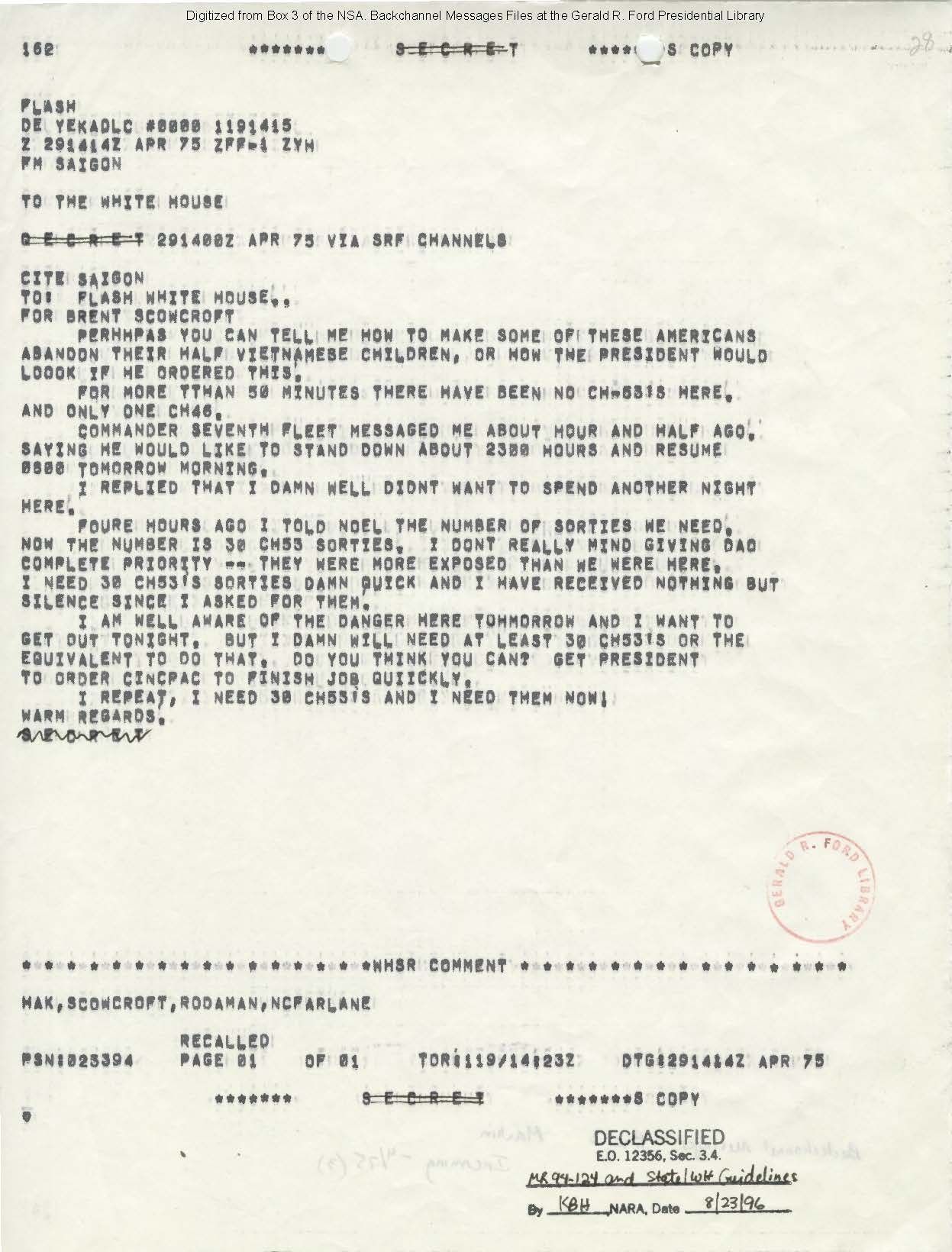
Document
Visitors search for names on the face of the Vietnam Veterans Memorial after its official dedication
11/13/1982
The Vietnam Veterans Memorial Wall lists more than 58,000 Americans who gave their lives in the Vietnam War. "The Wall that Heals" is one of the most popular sites on the National Mall.
According to the Vietnam Veterans Memorial Fund website, "More than 400,000 items have been left by visitors as remembrances and tributes. The National Park Service collects, catalogs, and preserves these objects as part of the Vietnam Veterans Memorial collection, with curatorial support from the Vietnam Veterans Memorial Fund."
According to the Vietnam Veterans Memorial Fund website, "More than 400,000 items have been left by visitors as remembrances and tributes. The National Park Service collects, catalogs, and preserves these objects as part of the Vietnam Veterans Memorial collection, with curatorial support from the Vietnam Veterans Memorial Fund."
This primary source comes from the Records of the Office of the Secretary of Defense.
National Archives Identifier: 6378061
Full Citation: Photograph 330-CFD-DF-ST-84-11915.jpeg; Visitors search for names on the face of the Vietnam Veterans Memorial after its official dedication; 11/13/1982; DFST8411915; Combined Military Service Digital Photographic Files, 1982 - 2007; Records of the Office of the Secretary of Defense, ; National Archives at College Park, College Park, MD. [Online Version, https://www.docsteach.org/documents/document/search-names-vietnam-memorial, April 20, 2024]Visitors search for names on the face of the Vietnam Veterans Memorial after its official dedication
Page 1
